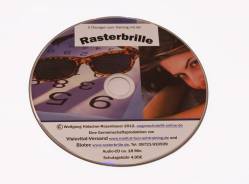Audio CD: Pinhole Glasses (only in German)
€4.95
Available, delivery time: 1-3 days
Product information "Audio CD: Pinhole Glasses (only in German)"
Eye relaxation and vision training with Pinhole Glasses
A training programme from the well-known eye trainer Wolfgang Hätscher-Rosenbauer
BioTec Dr. Egely & Lobmayer GmbH
Sendlingerstr. 8
84332 Hebertsfelden
Telefon: +49 8721 910939
Telefax: +49 8721 910938
E-Mail: info@biotec7.de
0 of 0 reviews
Average rating of 0 out of 5 stars
Login
Zubehör

Dimensions Scope of delivery Frame width: 130 mm Pinhole Glasses Arm length: 130 mm Spectacle case Bridge width: 18 mm Original Visus eye chart, the ideal aid for monitoring the progress of your eye training Weight: 15 g Detailed spectacle description Raster height: 45 mm Grid length: 54 mm Grid: pyramidal grid Scratch-resistant, square grid arranged in a pyramid shape on curved lenses. Experience shows that this full-surface grid is preferred for less than 2.0 dioptres and serves as prevention for non-spectacle wearers. Use: Integrate Pinhole Glasses or multidot glasses into your daily routine for 10 to 20 minutes per day. For long-sightedness, they are suitable for close-up tasks such as reading, and for short-sightedness, they are suitable for ‘eye jogging’ when looking into the distance – for example, when going for a walk or watching television. Benefits: Pinhole Glasses stimulate the eye to see actively again. The pinhole effect creates near-optical clarity, while the brain activates the eye muscles – a natural counterbalance to passive vision correction through lenses. Design: The aviator glasses – also known as pilot glasses – are perhaps the most famous classic among eyeglass frames. The unique combination of these iconic aviator glasses with the function of vision training glasses gives the model, which can be worn by both men and women, a particularly cool and casual touch in addition to its useful training application. Can also be used as sunglasses thanks to the darkening (no UV protection) of the grid. The trademarks: filigree, gold-coloured metal frame, teardrop-shaped grid lenses, a double bridge, silicone nose pads and reinforced plastic ends. Maintaining eye health in our hectic times Traditional eye exercises to strengthen vision are time-consuming and require disciplined practice to compensate for visual impairments in the long term. Training with pinhole glasses or pinhole glasses is well suited to modern ‘multitasking’. You can complete your daily training while doing other things, such as working on the computer. Eye training with pinhole glasses – an intelligent alternative for visual impairments In the modern and complex world of work, our eyes are exposed to one-sided strain on their adaptive capacity (problems with light-dark adjustment) and one-sided strain on their accommodative capacity (problems with near-far adjustment). These are usually the cause of declining vision or the development of vision problems. Vision training with pinhole glasses ‘breaks through’ this one-sidedness of vision. The eye learns to see naturally again. The origin of eye training according to William Bates William Bates, the forefather of eye training, proved through numerous experiments that vision can be retrained. According to his findings, it was not the lens of the eye that was responsible for ‘focusing’ and/or visual acuity, but rather the activity of the six external eye muscles. In 1920, he published his empirical findings in his classic work ‘Perfect Sight Without Glasses’. Based on his theory, Bates developed simple eye exercises for various visual impairments. This is known as the ‘Bates Method’. Later, the luminary among vision trainers, Janet Goodrich, built on the Bates Method and published the first studies on pinhole glasses or grid glasses. Additional product information: Manufacturer: BioTec Dr. Egely & Lobmayer GmbH, Sendlingerstr. 8, 84332 Hebertsfelden, Germany, Telephone: +49 8721 910939, Email: info@biotec7.de Warnings and safety instructions: Must not be used in road traffic. Unsuitable cleaning: The use of aggressive cleaning agents or improper handling can damage the glasses.

Dimensions Scope of delivery Frame width: 140 mm Pinhole Glasses Temple length: 130 mm Glasses case Bridge width: 15 mm Original Visus eye chart – the ideal aid for monitoring the progress of your eye training Weight: 21 g Detailed description of glasses Grid height: 40 mm Grid length: 70 mm Grid: bifocal dot grid With this type of grid, the dot grid in the upper viewing area of the curved lenses is smaller and denser, while in the lower viewing area it becomes larger and coarser. This enables a dynamic change in ‘focusing’ between relaxing (small holes) and training. Many years of experience show that this type of grid is preferred by people with more than 3.0 dioptres. Use: Train your eyes for 10 to 20 minutes every day with Pinhole Glasses or multidot glasses. Use them during everyday activities at home or at work. If you are long-sighted, wear them when reading. If you are short-sighted, use them when watching television, working at a computer screen or going for a walk. Benefits: Pinhole Glasses use the pinhole effect to enable you to see almost as clearly as with optical glasses. The brain sends out light signals that stimulate the eye muscles to actively focus – a form of training that strengthens natural vision. Design: The solid workmanship of these stylish, rather feminine glasses with an angular upper frame, brown tiger stripes and a solid frame meets all the requirements for good wearing comfort and is also a solid, attractive fashion accessory. Maintaining eye health in our hectic times Traditional eye exercises to strengthen vision are time-consuming and require disciplined practice to compensate for visual impairments in the long term. Training with pinhole glasses or pinhole glasses is ideal for modern ‘multitasking’: you can complete your daily training while doing your work on the computer, for example. Eye training with pinhole glasses – an intelligent alternative for visual impairments In today's modern and complex working world, our eyes are exposed to one-sided strain on their adaptation capacity (problems with light-dark adjustment) and accommodation capacity (problems with near-far adjustment). These are usually the cause of declining eyesight or the development of vision problems. Vision training with pinhole glasses ‘breaks through’ this one-sidedness of vision. The eye learns to see naturally again. The origins of eye training according to William Bates William Bates, the forefather of eye training, proved through numerous experiments that vision can be retrained. According to his findings, it was not the lens of the eye that was responsible for focusing and visual acuity, but rather the activity of the six external eye muscles. According to his findings, it was not the lens of the eye that was responsible for ‘focusing’ and visual acuity, but rather the activity of the six external eye muscles. In 1920, he published his empirical findings in his classic work ‘Perfect Sight Without Glasses’. Based on his theory, Bates developed simple eye exercises for various visual impairments – known as the ‘Bates Method’. Later, the luminary among vision trainers Janet Goodrich built on the Bates method and published the first studies on pinhole glasses and pinhole glasses. Additional product information: Manufacturer: BioTec Dr. Egely & Lobmayer GmbH, Sendlinger Str. 8, 84332 Hebertsfelden, Germany, Telephone: +49 8721 910939, Email: info@biotec7.de Warnings and safety instructions: Must not be used in road traffic. Inappropriate cleaning: The use of aggressive cleaning agents or improper handling can damage the glasses.

DimensionsScope of deliveryFrame width: 135 mmPinhole GlassesArm length: 145 mmSpectacle caseBridge width: 20 mmOriginal Visus eye chart, the ideal aid for monitoring the progress of your eye trainingWeight: 17 gDetailed spectacle descriptionGrid height: 35 mmGrid length: 50 mmGrid: classic round hole grid The curved lenses have a full-surface, slightly coarser round grid, allowing a particularly large amount of light to pass through. This type of grid is universally applicable and is also ideal for prevention. Everyday use Wear the Pinhole Glasses – also known as multidot glasses – every day for about 10 to 20 minutes while going about your usual activities. Long-sightedness: helpful for reading and close-up work Short-sightedness: promotes distance vision, e.g. when watching television or taking a relaxing walk Effect & impact Pinhole Glasses support the visual process holistically. The physical pinhole effect creates a clear image without optical lenses. At the same time, the eye muscles are activated, which trains and strengthens the eye's natural ability to focus. Material & comfort The high-quality, silver-anodised metal frame is timeless and suitable for both women and men. Thanks to soft silicone nose pads and reinforced plastic ends, the glasses impress with their optician quality and comfortable fit. Maintaining eye health in a hectic everyday life Classic vision exercises require a lot of discipline and time. Training with grid or pinhole glasses, on the other hand, is suited to modern multitasking: you can complete your daily training while working on the computer, for example. Pinhole Glasses – a smart alternative for visual impairments In today's working life, the eyes are often subjected to one-sided strain: Adaptation: Difficulties in adjusting to light and dark conditions Accommodation: Problems switching between near and distant vision These stresses are often the cause of declining vision. With regular vision training using pinhole glasses, you can break through this one-sidedness and promote natural vision again. The beginnings according to William Bates William Bates, the founder of eye training, demonstrated in experiments that vision can be trained. He discovered that it is not the lens, but the outer six eye muscles that are responsible for focusing. In 1920, he published his findings in the classic Perfect Sight Without Glasses. Based on this, he developed the Bates Method. Later, Janet Goodrich took up these approaches and published the first studies on the effectiveness of grid or pinhole glasses. Additional product information Manufacturer: BioTec Dr. Egely & Lobmayer GmbH Sendlingerstr. 8, 84332 Hebertsfelden, Germany Telephone: +49 8721 910939 Email: info@biotec7.de Warnings and safety instructions Do not use in road traffic. Do not use aggressive cleaning agents, as they may damage the glasses.
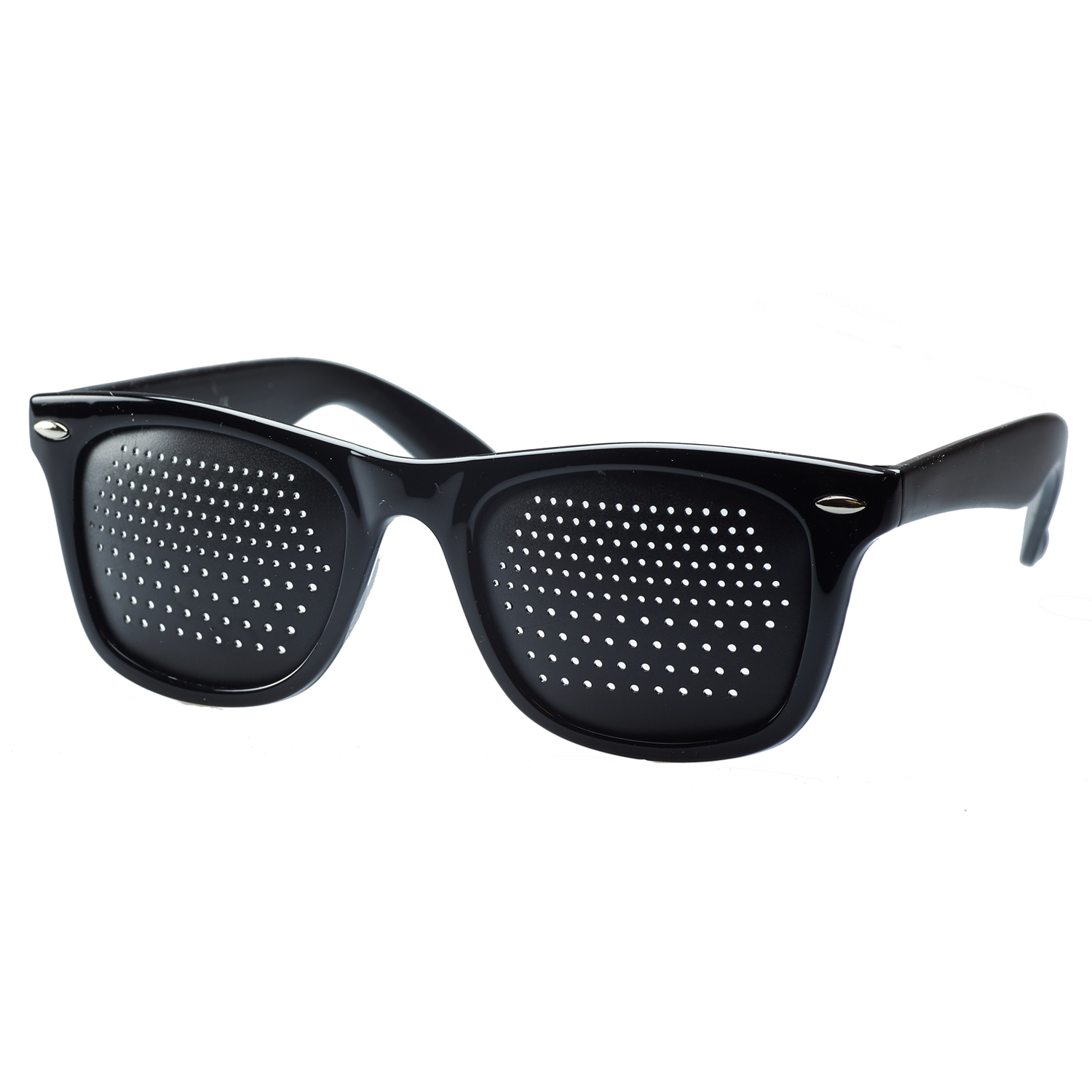
Dimensions Scope of delivery Frame width: 135 mm Pinhole Glasses Temple length: 140 mm Spectacle case Bridge width: 15 mm Original Visus eye chart, the ideal aid for monitoring the progress of your eye training Weight: 22 g Detailed description of glasses Grid height: 40 mm Grid length: 70 mm Raster: Bifocal dot raster With this type of raster, the dot raster in the upper viewing area of the curved lenses is smaller and denser, while in the lower viewing area it becomes larger and coarser. This enables a dynamic change in ‘focusing’ between relaxation (small holes) and training. Many years of experience show that this type of grid is preferred by people with over 3.0 dioptres. Use: The Pinhole Glasses or multidot glasses are ideal for short, daily vision training lasting 10 to 20 minutes. Use them in everyday life – for long-sightedness when reading, for short-sightedness when watching television or going for a walk. Benefits: Pinhole Glasses training is a simple method for strengthening eye function. The pinhole effect improves visual acuity, and the brain takes on the role of a stimulus generator, stimulating the eye muscles to actively focus. Design: The expressive shiny black plastic frame, finished with silver-coloured decorative rivets at the top of the frame, for ladies and gentlemen, impresses with its high-quality workmanship, which makes the glasses extremely comfortable to wear and gives them an elegant touch. Maintaining eye health in our hectic times Traditional eye exercises to strengthen vision are time-consuming and require disciplined practice to compensate for visual impairments in the long term. Training with pinhole glasses or pinhole glasses is more in line with modern ‘multitasking’. You complete your daily training and can do your work on the computer, for example, at the same time. Eye training with pinhole glasses – an intelligent alternative for visual impairments In today's modern and complex working world, our eyes are exposed to one-sided strain: adaptation (problems with light-dark adjustment) and accommodation (problems with near-far adjustment). This often leads to declining vision. Vision training with pinhole glasses breaks through this one-sidedness of vision. The eye learns to see naturally again. The origin of eye training according to William Bates William Bates, the forefather of eye training, proved through numerous experiments that vision can be retrained. It is not the lens of the eye that is responsible for ‘focusing’ and visual acuity, but the activity of the six external eye muscles. In 1920, he published his findings in ‘Perfect Sight Without Glasses’. Bates developed simple eye exercises for various visual impairments, known as the Bates Method. Later, Janet Goodrich built on this and published the first studies on grid or pinhole glasses. Additional product information: Manufacturer: BioTec Dr. Egely & Lobmayer GmbH, Sendlingerstr. 8, 84332 Hebertsfelden, Germany, Telephone: +49 8721 910939, Email: info@biotec7.de Warnings and safety instructions: Must not be used in road traffic. Improper cleaning or aggressive cleaning agents can damage the glasses.

Dimensions Scope of delivery Frame width: 140 mm Pinhole Glasses Temple length: 115 mm Glasses case Bridge width: 20 mm Original Visus eye chart, the ideal aid for monitoring the progress of your eye training Weight: 20 g Detailed description of glasses Grid height: 35 mm Grid length: 55 mm Grid: Bifocal dot grid With this type of grid, the dot grid in the upper viewing area of the curved lenses is smaller and denser, while in the lower viewing area it becomes larger and coarser. This enables a dynamic change in ‘focusing’ between relaxation (small holes) and training. Many years of experience show that this type of grid is preferred by people with more than 3.0 dioptres. Use: Train for 10–20 minutes every day with the Pinhole Glasses or Multidot Glasses. Use them regularly during your daily activities. Long-sighted people wear them when reading, short-sighted people when watching television or going for walks with a distant focus. Benefits: The pinhole effect of the pinhole Glasses enables sharp vision without optical lenses. At the same time, the eye muscles are specifically activated by the brain – a training that supports and maintains the natural function of the eye. Design: These brown, slim-fit glasses frames for women and men make a fashionable, sporty statement. With side light protection, you can get the most out of your training sessions. Maintaining eye health in our hectic times Traditional vision exercises to strengthen eyesight are time-consuming and require disciplined practice to compensate for long-term visual impairments. Training with pinhole glasses or pinhole glasses supports modern ‘multitasking’. You can complete your daily training while working on the computer, for example. Eye training with pinhole glasses – an intelligent alternative for visual impairments In the modern working world, our eyes are exposed to one-sided strain: adaptation performance (problems with light-dark adjustment) and accommodation performance (problems with near-far adjustment). This often leads to declining vision. Vision training with pinhole glasses breaks through this one-sidedness of vision. The eye learns to see naturally again. The origin of eye training according to William Bates William Bates, the forefather of eye training, proved through numerous experiments that vision can be retrained. It is not the lens of the eye that is responsible for ‘focusing’ and visual acuity, but the activity of the six external eye muscles. In 1920, he published his empirical findings in his classic work ‘Perfect Sight Without Glasses’. Bates developed simple eye exercises for various visual impairments, known as the Bates method. Later, Janet Goodrich built on this and published the first studies on grid or pinhole glasses. Additional product information: Manufacturer: BioTec Dr. Egely & Lobmayer GmbH, Sendlingerstr. 8, 84332 Hebertsfelden, Germany, Telephone: +49 8721 910939, Email: info@biotec7.de Warnings and safety instructions: Must not be used in road traffic. Improper cleaning or aggressive cleaning agents can damage the glasses.
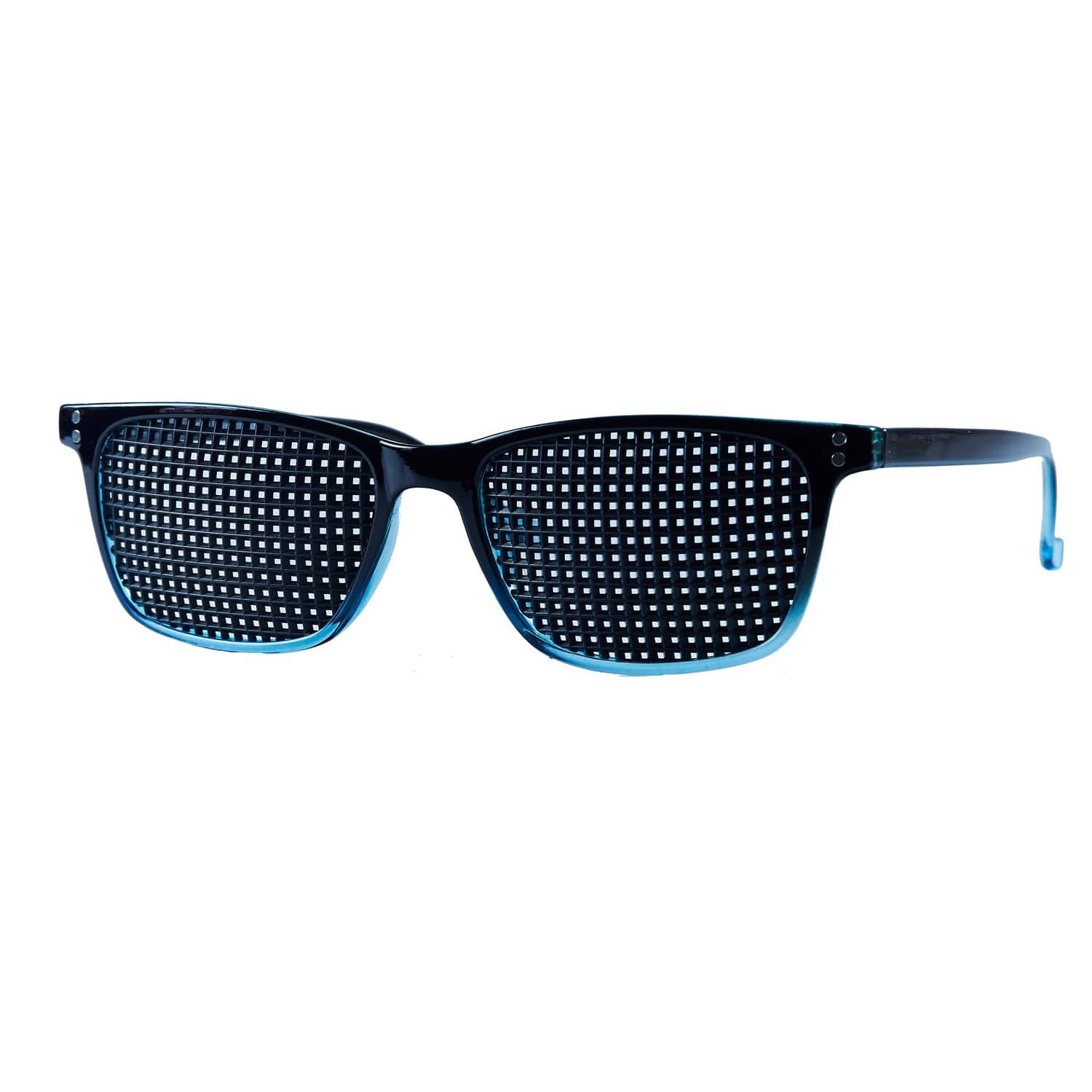
DimensionsScope of deliveryFrame width: 140 mmPinhole GlassesTemple length: 140 mmSpectacle caseBridge width: 17 mmOriginal Visus eye chart, the ideal aid for monitoring the progress of your eye trainingWeight: 14 gDetailed spectacle descriptionRaster height: 35 mmGrid length: 55 mmABP grid glasses – targeted eye training Grid: pyramidal grid A scratch-resistant, square grid arranged in a pyramid shape is integrated into curved lenses. This full-surface grid is preferred for less than 2.0 dioptres and serves as prevention for non-spectacle wearers. Use A daily training session of 10–20 minutes is sufficient. The Pinhole Glasses can be perfectly integrated into everyday life: At work When reading When watching television They support both short-sighted and long-sighted people, depending on their individual vision needs. Benefits Training with pinhole glasses actively stimulates the eye. In contrast to passive corrective glasses, pinhole glasses challenge the eye muscles. Supported by the pinhole effect and the central nervous system, natural focusing is reactivated. Design High-quality plastic frame in a slightly rectangular shape with a modern black-blue colour gradient. Two subtle metal decorations on the outer frame and a durable spring hinge ensure a good fit for any head size and a high-quality look. Eye health in everyday life Traditional vision exercises are time-consuming. Pinhole glasses allow for effective training alongside everyday activities such as working on the computer, reading or going for a walk. Intelligent vision training Modern working conditions place a one-sided strain on the eyes: Adaptation performance: light-dark adjustment Accommodation performance: near-far focusing Pinhole glasses break this one-sided strain and enable active, natural vision. History of eye training according to William Bates William Bates showed that visual acuity is determined by the activity of the six external eye muscles. In 1920, he published Perfect Sight Without Glasses and developed the Bates Method. Later, Janet Goodrich conducted the first studies on grid and pinhole glasses. Product information Manufacturer: BioTec Dr. Egely & Lobmayer GmbH Sendlingerstr. 8, 84332 Hebertsfelden, Germany Telephone: +49 8721 910939 Email: info@biotec7.de Safety and warning instructions Do not use in road traffic. Clean only with mild cleaning agents. Aggressive agents or improper handling can damage the glasses.
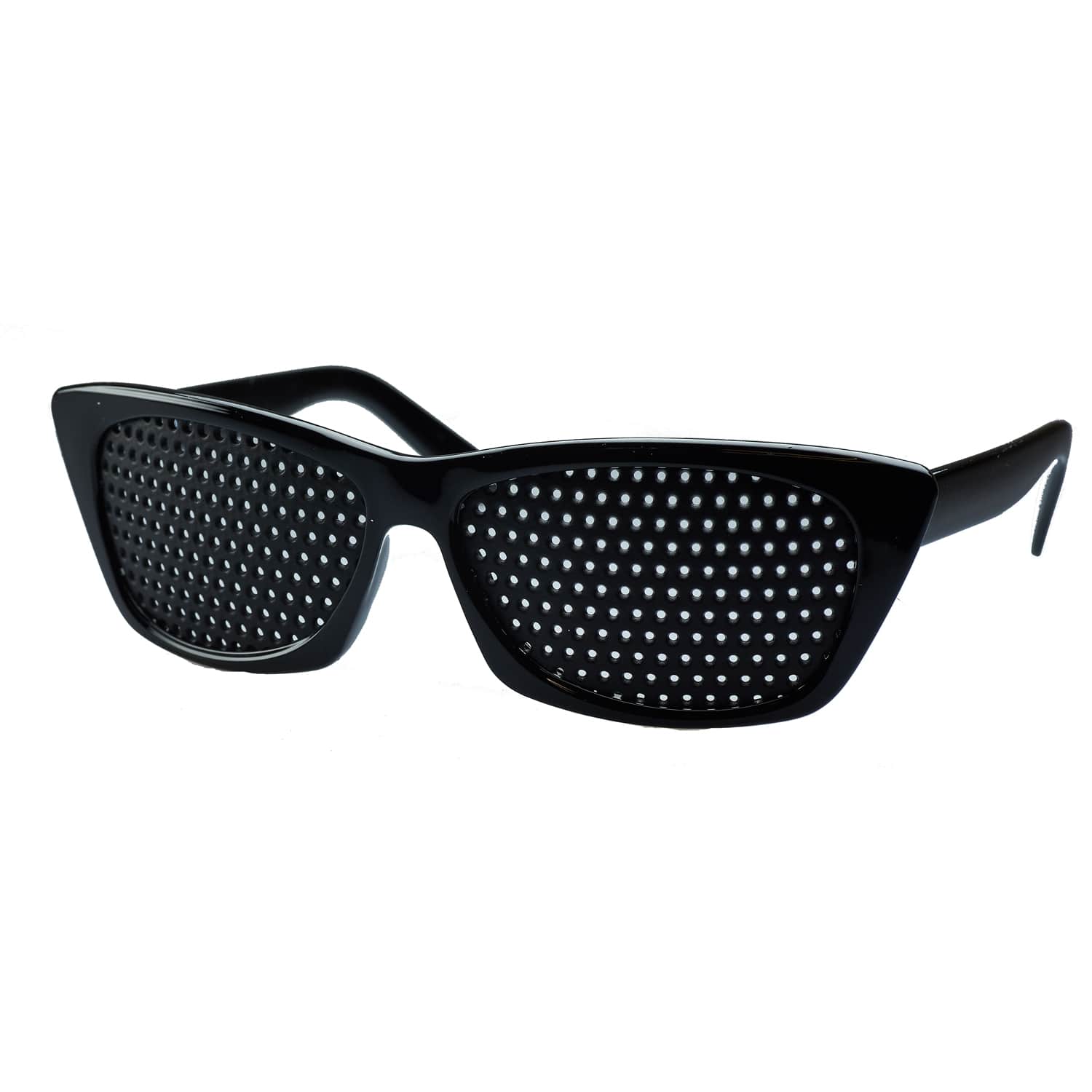
DimensionsScope of deliveryFrame width: 140 mmPinhole GlassesTemple length: 130 mmGlasses caseBridge width: 15 mmOriginal Visus eye chart, the ideal aid for monitoring the progress of your eye trainingWeight: 21 gDetailed description of glassesGrid height: 40 mmGrid length: 70 mmGrid: classic round hole grid The curved lenses have a continuous, coarser round grid, which allows a particularly large amount of light to enter the eye. This type of grid is suitable for almost everyone and is also often used preventively. How to use the glasses Wear the Pinhole Glasses – also known as multidot glasses – for 10 to 20 minutes every day while carrying out your usual activities: For long-sightedness: ideal for reading or close-up work For short-sightedness: to activate distance vision, e.g. when watching television, working at a computer screen or going for a walk Your advantages Pinhole Glasses are not only a visual aid, but also a training device. The pinhole effect stimulates the eye to actively focus on objects. This promotes natural eye movement – in contrast to the passive adjustment that occurs when wearing corrective glasses. Frame & comfort High-quality spectacle frames in a feminine design: slightly angular at the top, in an elegant glossy black, with sturdy frames. Functional and fashionable at the same time – an accessory that is extremely comfortable to wear. Eye health in modern everyday life Classic vision exercises require a lot of time and perseverance. Training with grid or pinhole glasses, on the other hand, can be easily integrated into your daily routine. This allows you to complete your daily eye training while performing activities such as working on the computer. Pinhole glasses as an alternative training method for visual impairments In our complex working world, our eyes are often subjected to one-sided strain: Adaptation: Difficulties in adjusting to light and dark conditions Accommodation: Problems switching between near and far vision This strain often leads to declining vision. By regularly using pinhole glasses, you can break this one-sidedness and promote natural vision again. The origins according to William Bates William Bates, the founder of modern eye training, demonstrated in numerous experiments that vision can be trained. He discovered that it is not the lens, but the outer six eye muscles that enable focusing. In 1920, he published his findings in the work Perfect Sight Without Glasses. Based on this, he developed the Bates Method with simple eye exercises. Later, Janet Goodrich took up these approaches and published the first studies on the effect of grid or pinhole glasses. Additional product information Manufacturer: BioTec Dr. Egely & Lobmayer GmbH Sendlingerstr. 8, 84332 Hebertsfelden, Germany Telephone: +49 8721 910939 Email: info@biotec7.de Warnings and safety instructions Do not use in road traffic. Do not use aggressive cleaning agents, as they may damage the glasses.

DimensionsScope of deliveryFrame width: 140 mmPinhole GlassesArm length: 115 mmSpectacle caseBridge width: 20 mmOriginal Visus eye chart, the ideal aid for monitoring the progress of your eye trainingWeight: 20 gDetailed spectacle descriptionRaster height: 35 mmGrid length: 55 mmGrid: pyramidal grid The curved lenses contain a scratch-resistant, square grid arranged in a pyramid shape. Experience shows that this grid is preferred for prescriptions under 2.0 dioptres and is used by non-spectacle wearers for prevention purposes. Use: Wear the Pinhole Glasses or multidot glasses for 10–20 minutes every day while performing everyday tasks. People who are long-sighted benefit when reading, while those who are short-sighted activate their vision when watching television, working on a computer or walking in the distance. Benefits: Wearing Pinhole Glasses initiates a natural training process. The pinhole effect ensures almost sharp vision, while the eye muscles are activated by the brain to focus – a training effect that normal glasses do not offer. Design: This blue, slim-fit frame for men and women combines a fashionable sporty look with functionality. The side light protection optimises training with Multidot glasses. Maintaining eye health in our hectic times Traditional vision exercises are time-consuming and require discipline. With pinhole glasses, training sessions can be easily integrated into everyday life, e.g. while working at a computer. Eye training – an intelligent alternative for visual impairments In the modern working world, our eyes are often subjected to one-sided strain – both in adapting to light-dark stimuli and in focusing on near and far objects. Training with pinhole glasses breaks through this one-sidedness and promotes natural visual function. The origins of eye training according to William Bates William Bates proved that visual acuity is primarily controlled by the activity of the six external eye muscles. In 1920, he published his findings in ‘Perfect Sight Without Glasses’. The methods were further developed by Janet Goodrich and applied to grid and pinhole glasses. Additional product information: Manufacturer: BioTec Dr. Egely & Lobmayer GmbH, Sendlingerstr. 8, 84332 Hebertsfelden, Germany, Telephone: +49 8721 910939, Email: info@biotec7.de Warnings and safety instructions: Do not use while driving. Improper cleaning or aggressive cleaning agents can damage the glasses.

DimensionsScope of deliveryFrame width: 130 mmPinhole GlassesArm length: 130 mmSpectacle caseBridge width: 18 mmOriginal Visus eye chart, the ideal aid for monitoring the progress of your eye trainingWeight: 15 gDetailed spectacle descriptionRaster height: 45 mmGrid length: 54 mmGrid: classic round hole grid The curved lenses feature a full-surface, coarser round grid, offering maximum light incidence. This type of grid is suitable for everyone and can also be worn prophylactically. Application Daily training with Pinhole Glasses or multidot glasses for 10–20 minutes. Wear the glasses while carrying out your usual activities: Long-sighted people: when reading Short-sighted people: when working at a computer screen, watching television or focusing on distant objects Benefits The physical pinhole effect provides surprisingly sharp vision without traditional lenses. The eye muscles are activated to focus the image independently – a holistic vision training. Design & style The pilot glasses, also known as aviators, are a classic frame combined with the function of vision training glasses. They are suitable for both men and women and can also be used as sunglasses (no UV protection). Special features: Teardrop-shaped raster lenses Double bridge Silicone nose pads and reinforced plastic ends Eye health in everyday life Traditional vision exercises are time-consuming and require discipline. Training with grid or pinhole glasses fits perfectly into modern everyday life: you train your eyes while working on the computer, for example. Intelligent vision training In the modern working world, our eyes are often subjected to one-sided strain: Adaptation: problems with light-dark adjustments Accommodation: Difficulties switching between near and distant vision Training with pinhole glasses breaks this one-sidedness and promotes natural, active vision. The eye learns to focus independently again. Origin according to William Bates William Bates proved that visual acuity does not depend on the lens of the eye, but on the six external eye muscles. In 1920, he published Perfect Sight Without Glasses and developed the Bates method. Later, Janet Goodrich built on this and published the first studies on grid and pinhole glasses. Product information Manufacturer: BioTec Dr. Egely & Lobmayer GmbH Sendlingerstr. 8, 84332 Hebertsfelden, Germany Telephone: +49 8721 910939 Email: info@biotec7.de Safety and warning information The glasses must not be used in road traffic. Clean only with mild cleaning agents – aggressive agents or improper handling can damage the glasses.

Dimensions Scope of delivery Frame width: 140 mm Pinhole Glasses Temple length: 140 mm Glasses case Bridge width: 17 mm Original Visus eye chart, the ideal aid for monitoring the progress of your eye training Weight: 14 g Detailed description of glasses Grid height: 35 mm Grid length: 55 mm Grid: Bifocal dot grid With this type of grid, the dot grid in the upper viewing area of the curved lenses is smaller and denser, while in the lower viewing area it becomes larger and coarser. This enables a dynamic change in ‘focusing’ between relaxing (small holes) and training. Many years of experience show that this type of grid is preferred by people with more than 3.0 dioptres. Use: 10–20 minutes of Pinhole Glasses training every day. Use the glasses for everyday tasks around the house or at work. If you are long-sighted, wear them when reading; if you are short-sighted, activate your eyes for distance vision with multidot glasses – e.g. when watching television or going for a walk. Benefits: Wearing the pinhole glasses forces the eye to focus independently. The pinhole effect enables almost clear vision, and the brain takes on an active role by stimulating the eye muscles – without any optical amplification. Design: High-quality plastic frame in a slightly rectangular shape with a trendy black and reddish colour gradient and two delicate metal decorations on the outer frame. A durable spring hinge adapts perfectly to the size of the head. Maintaining eye health in our hectic times Traditional eye exercises to strengthen vision are time-consuming and require disciplined practice to compensate for visual impairments in the long term. Training with pinhole glasses or pinhole glasses is well suited to modern ‘multitasking’. You can complete your daily training while doing other things, such as working on your computer. Eye training with pinhole glasses – an intelligent alternative for visual impairments In today's modern and complex working world, our eyes are exposed to one-sided strain on their adaptive capacity (problems with light-dark adjustment) and one-sided strain on their accommodative capacity (problems with near-far adjustment). These are usually the cause of declining vision or the development of vision problems. Vision training with pinhole glasses ‘breaks through’ this one-sidedness of vision. The eye learns to see naturally again. The origin of eye training according to William Bates William Bates, the forefather of eye training, proved that vision can be retrained through numerous experiments. According to his findings, it was not the lens of the eye that was responsible for ‘focusing’ and/or visual acuity, but rather the activity of the six external six eye muscles. In 1920, he published his empirical findings in his classic work ‘Perfect Sight Without Glasses’. Based on his theory, Bates developed simple eye exercises for various visual impairments. This is known as the ‘Bates method’. Later, the luminary among vision trainers Janet Goodrich built on the Bates method and published the first studies on pinhole glasses or pinhole lenses. Additional product information: Manufacturer: BioTec Dr. Egely & Lobmayer GmbH, Sendlingerstr. 8, 84332 Hebertsfelden, Germany, Telephone: +49 8721 910939, Email: info@biotec7.de Warnings and safety instructions: Must not be used in road traffic. Inappropriate cleaning: The use of aggressive cleaning agents or improper handling can damage the glasses.

DimensionsScope of deliveryFrame width: 140 mmPinhole GlassesArm length: 115 mmSpectacle caseBridge width: 20 mmOriginal Visus eye chart, the ideal aid for monitoring the progress of your eye trainingWeight: 20 gDetailed spectacle descriptionRaster height: 35 mmGrid length: 55 mmGrid: pyramidal grid A scratch-resistant, square grid arranged in a pyramid shape is integrated into curved lenses. Experience shows that this grid is preferred for prescriptions under 2.0 dioptres and serves as prevention for non-spectacle wearers. Use: Wear the Pinhole Glasses or multidot glasses for 10–20 minutes every day during everyday activities at home or at work. People who are long-sighted use the glasses when reading, while those who are short-sighted use them when watching television, looking at a screen or going for a walk and looking into the distance. Benefits: The pinhole glasses activate natural eye movement. The pinhole effect enables almost sharp vision, while the brain stimulates the eye muscles and actively focuses the image – a training effect that normal glasses do not offer. Design: The slim-fit brown frames are suitable for both men and women and make a fashionable, sporty statement. Side light protection optimises training sessions with Multidot glasses. Maintaining eye health in our hectic times Traditional vision exercises require a lot of time and discipline. With pinhole glasses, training can be easily integrated into everyday life, e.g. while working at the computer. Eye training – an intelligent alternative for visual impairments Modern working environments often place a one-sided strain on the eyes – both in terms of adapting to light and dark stimuli and in terms of focusing on near and far objects. Training with pinhole glasses breaks through this one-sidedness and promotes natural vision function. The origins of eye training according to William Bates William Bates proved that visual acuity is primarily controlled by the activity of the six external eye muscles. In 1920, he published his findings in ‘Perfect Sight Without Glasses’. Janet Goodrich later developed training methods for grid and pinhole glasses based on these findings. Additional product information: Manufacturer: BioTec Dr. Egely & Lobmayer GmbH, Sendlingerstr. 8, 84332 Hebertsfelden, Germany, Telephone: +49 8721 910939, Email: info@biotec7.de Warnings and safety instructions: Do not use in road traffic. Improper cleaning or aggressive cleaning agents can damage the glasses.
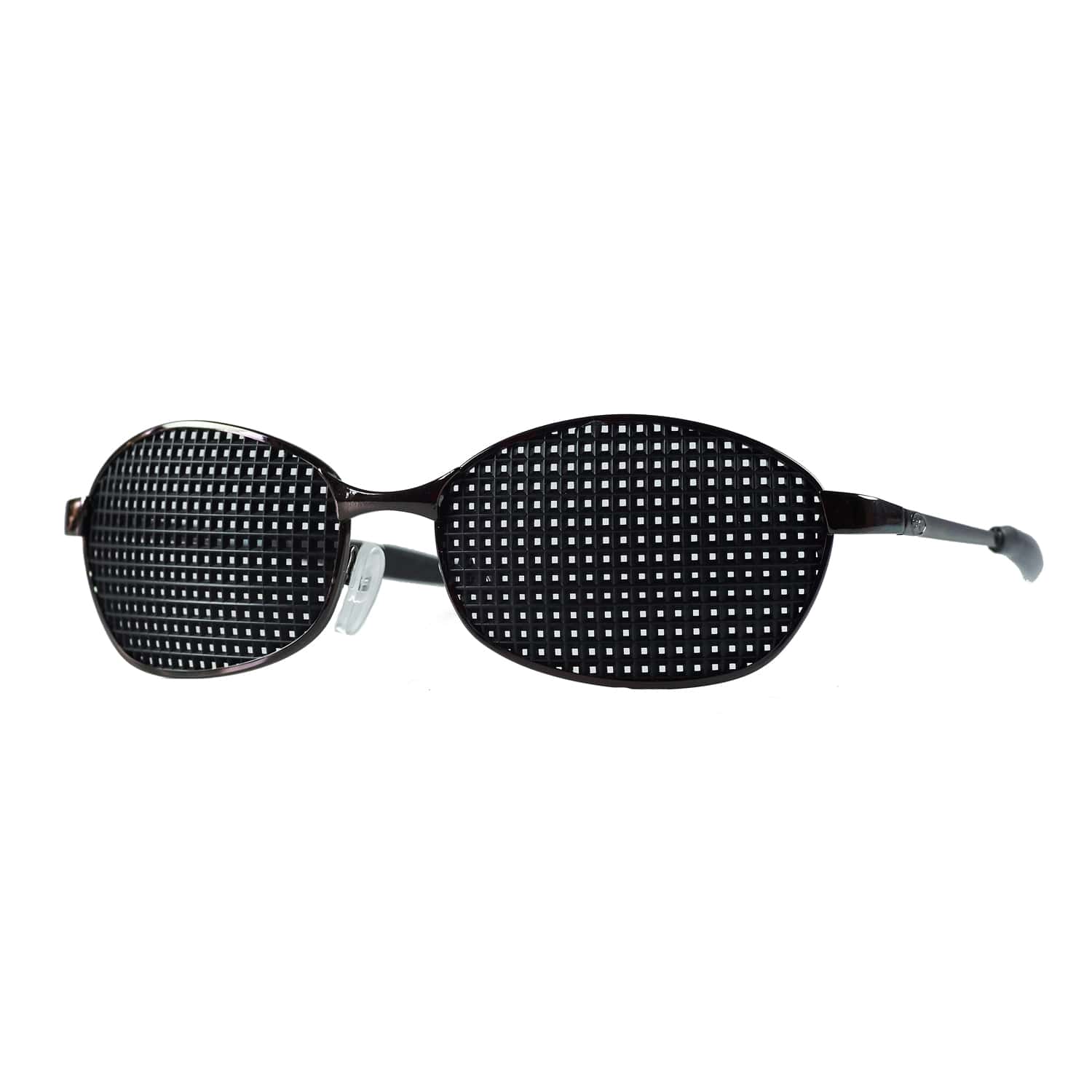
DimensionsScope of deliveryFrame width: 140 mmPinhole GlassesTemple length: 130 mmSpectacle caseBridge width: 18 mmOriginal Visus eye chart, the ideal aid for monitoring the progress of your eye trainingWeight: 20 gDetailed spectacle descriptionRaster height: 35 mmGrid length: 58 mmGrid: pyramidal grid A scratch-resistant, square grid arranged in a pyramid shape is integrated into curved lenses. Experience shows that this grid is preferred for 2.0 dioptres and serves as prevention for non-spectacle wearers. Use: 10–20 minutes of daily vision training with Pinhole Glasses or multidot glasses will improve your eye function. For long-sightedness, we recommend using them when reading; for short-sightedness, when working at a screen, watching television or looking into the distance. Benefits: Pinhole Glasses use the pinhole effect to promote natural vision. The eye muscles are stimulated by signals from the brain to focus independently again – a process that is often impaired by conventional glasses. Design: The silver-anodised metal frame in optician quality offers high wearing comfort. The curved side lenses protect the eyes from scattered light. Unisex model with silicone nose pads and reinforced plastic ends. Maintaining eye health in our hectic times Traditional vision exercises are time-consuming and require disciplined practice. Training with grid or pinhole glasses is ideal for modern multitasking – you train your eyes while working on the computer, for example. Eye training – an intelligent alternative for visual impairments In the modern working world, our eyes are exposed to one-sided strain: adaptation (light-dark) and accommodation (near-far) are heavily stressed. Training with pinhole glasses breaks through this one-sidedness and supports natural vision. The origins of eye training according to William Bates William Bates proved that visual acuity does not primarily depend on the lens of the eye, but on the activity of the six external eye muscles. In 1920, he published his findings in ‘Perfect Sight Without Glasses’. Janet Goodrich later developed training methods for grid and pinhole glasses based on these findings. Additional product information: Manufacturer: BioTec Dr. Egely & Lobmayer GmbH, Sendlingerstr. 8, 84332 Hebertsfelden, Germany, Telephone: +49 8721 910939, Email: info@biotec7.de Warnings and safety instructions: Do not use in road traffic. Improper cleaning or aggressive cleaning agents can damage the glasses.
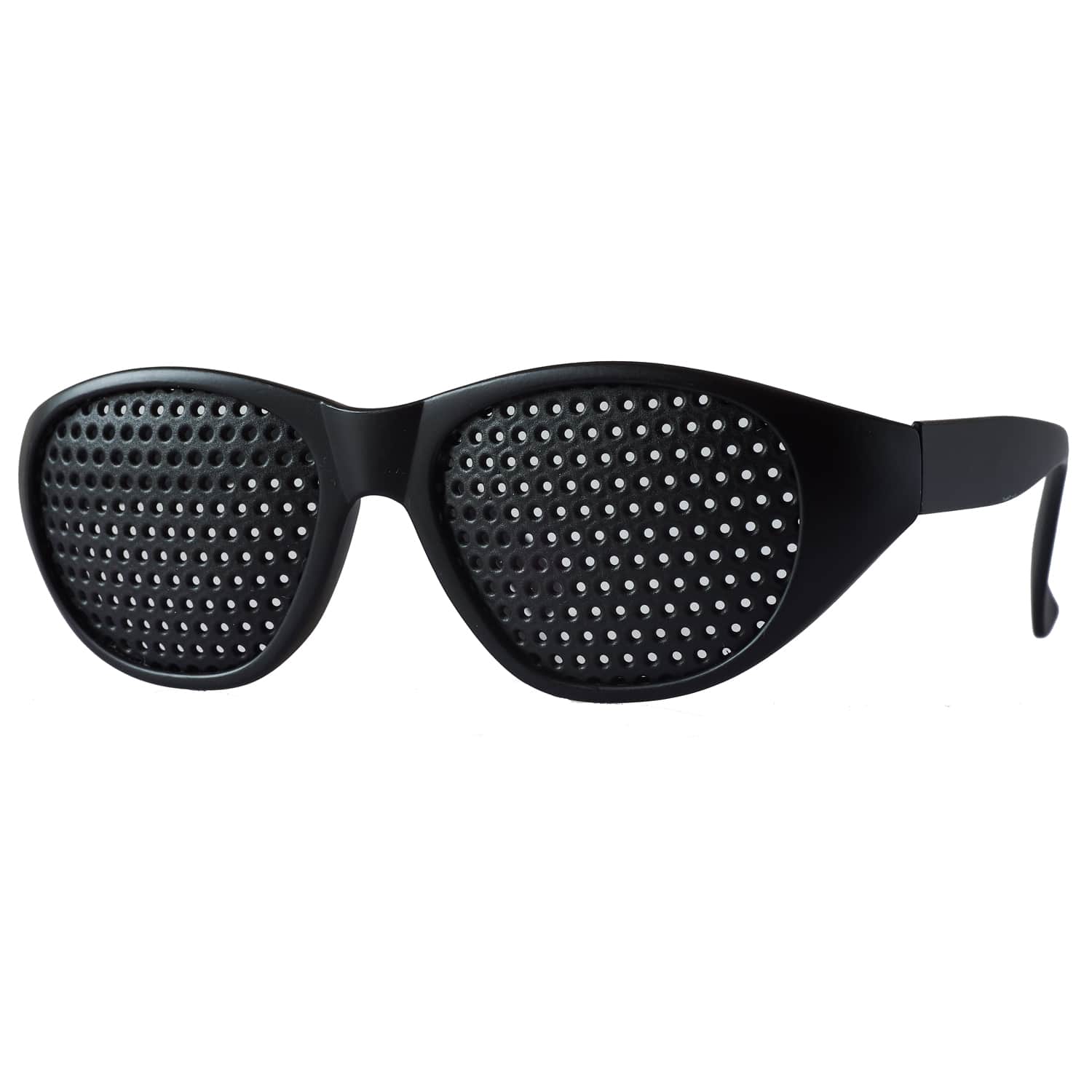
DimensionsScope of deliveryFrame width: 140 mmPinhole GlassesArm length: 120 mmSpectacle caseBridge width: 15 mmOriginal Visus eye chart, the ideal aid for monitoring the progress of your eye trainingWeight: 23 gDetailed spectacle descriptionRaster height: 40 mmGrid length: 50 mmGrid: classic round hole grid The curved lenses have a full-surface, slightly coarser round grid, allowing a particularly large amount of light to pass through. This type of grid is suitable for everyone and can also be worn preventively. Recommended use Use the Pinhole Glasses – also known as multidot glasses – for 10 to 20 minutes every day while performing your daily tasks at home or at work. Long-sightedness: ideal for reading and close-up work Short-sightedness: training for distance vision, e.g. when watching television or going for a walk Your advantages With Pinhole Glasses, you can actively improve your vision. The pinhole effect creates an almost clear image, comparable to optically ground lenses. The eyes are stimulated to focus independently – in contrast to the passive support provided by conventional corrective glasses. Frame & comfort The sturdy, matte black panto-style frame combines slightly oval curves at the top with a rounded shape at the bottom. High-quality details such as flexible spring hinges ensure that the glasses fit perfectly for both men and women. An additional advantage: the side shielding, which prevents distracting light from entering during training. Promoting eye health in everyday life Traditional vision exercises are often time-consuming and require a lot of discipline. Training with grid or pinhole glasses, on the other hand, fits perfectly into modern everyday life: you strengthen your eyes while working on the computer or doing other activities. A smart training alternative for visual impairments In today's working world, the eyes are often exposed to one-sided strain: Adaptation performance: Difficulties in adjusting to light and dark conditions Accommodation: Problems switching between near and far vision This one-sided strain can lead to declining vision. With regular vision training using pinhole glasses, you can break this pattern and promote natural vision again. The origins according to William Bates William Bates, the founder of eye training, demonstrated through experiments that vision can be trained. He discovered that it is not the lens of the eye, but the six external eye muscles that are responsible for focusing. In 1920, he published his findings in his classic work Perfect Sight Without Glasses. Based on this, he developed the Bates Method. Later, Janet Goodrich took up these approaches and published the first studies on the effectiveness of pinhole glasses. Additional product information Manufacturer: BioTec Dr. Egely & Lobmayer GmbH Sendlingerstr. 8, 84332 Hebertsfelden, Germany Telephone: +49 8721 910939 Email: info@biotec7.de Warnings and safety instructions Do not use in road traffic. Do not use aggressive cleaning agents to avoid damage.
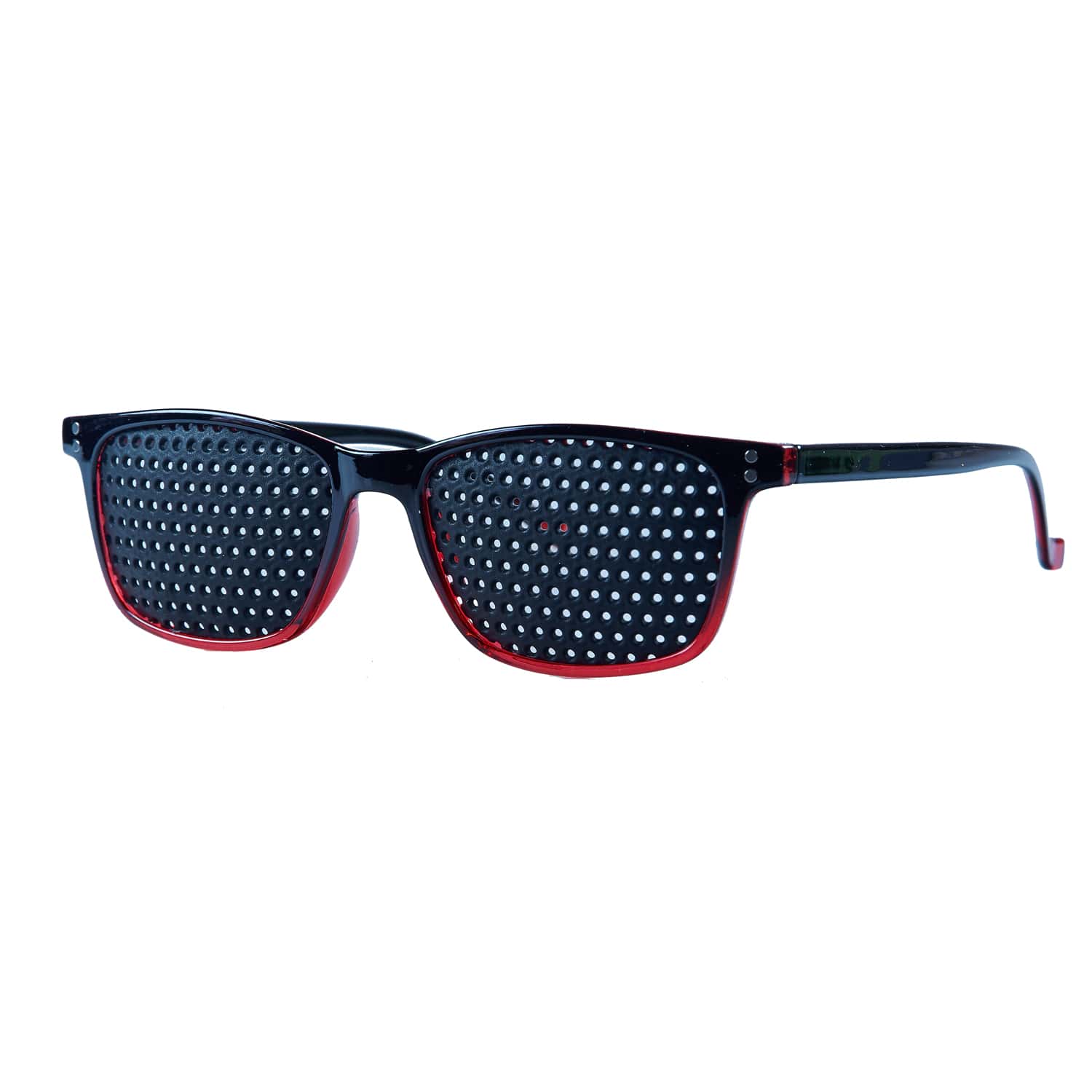
DimensionsScope of deliveryFrame width: 140 mmPinhole GlassesArm length: 140 mmSpectacle caseBridge width: 17 mmOriginal Visus eye chart, the ideal aid for monitoring the progress of your eye trainingWeight: 14 gDetailed spectacle descriptionRaster height: 35 mmGrid length: 55 mmGrid: classic round hole grid The curved lenses feature a continuous, slightly coarser round grid. This maximises the incidence of light. This type of grid is universally suitable and is often used as a precautionary measure. Use Wear the Pinhole Glasses or multidot glasses for about 10 to 20 minutes every day. They can be easily integrated into your daily routine: For long-sightedness: suitable for close-up activities, e.g. reading For short-sightedness: distance training, e.g. watching television or going for walks Benefits Training with pinhole glasses is a holistic method for improving vision quality and relaxing the eyes. The so-called pinhole effect ensures that the image appears almost as sharp as with corrective glasses. When using pinhole glasses, the brain stimulates the eye muscles, reactivating the natural focusing process . Design Robust plastic frame in a rectangular shape, carefully crafted with a modern black and reddish colour gradient. Fine metal accents on the outer sides and a flexible spring hinge guarantee a comfortable fit for different head sizes. Maintaining eye health in everyday life Traditional eye exercises require a lot of time and perseverance. Training with grid or pinhole glasses, on the other hand, can be easily integrated into your daily routine. You can perform your vision exercises while simultaneously completing tasks such as working on the computer. Eye training with pinhole glasses – a modern alternative for visual impairments Today's professional and everyday life puts a strain on the eyes in one way: Adaptation: Difficulties in adjusting to light and dark Accommodation: Problems switching between near and far vision These stresses are often the cause of declining vision. Training with pinhole glasses breaks this one-sidedness and promotes natural vision again. The beginnings of eye training according to William Bates William Bates, founder of eye training, was able to show in numerous experiments that vision can be trained. He discovered that it is not the lens of the eye, but the six outer eye muscles that are crucial for focusing. In 1920, he published his research findings in the work Perfect Sight Without Glasses. Based on this, he developed the so-called Bates Method with simple, effective eye exercises. Later, Janet Goodrich took up these approaches and conducted the first studies on the effect of grid and pinhole glasses. Additional product information Manufacturer: BioTec Dr. Egely & Lobmayer GmbH Sendlingerstr. 8, 84332 Hebertsfelden, Germany Telephone: +49 8721 910939 Email: info@biotec7.de Warnings and safety instructions Do not use in road traffic. Do not use aggressive cleaning agents, as they can damage the material.
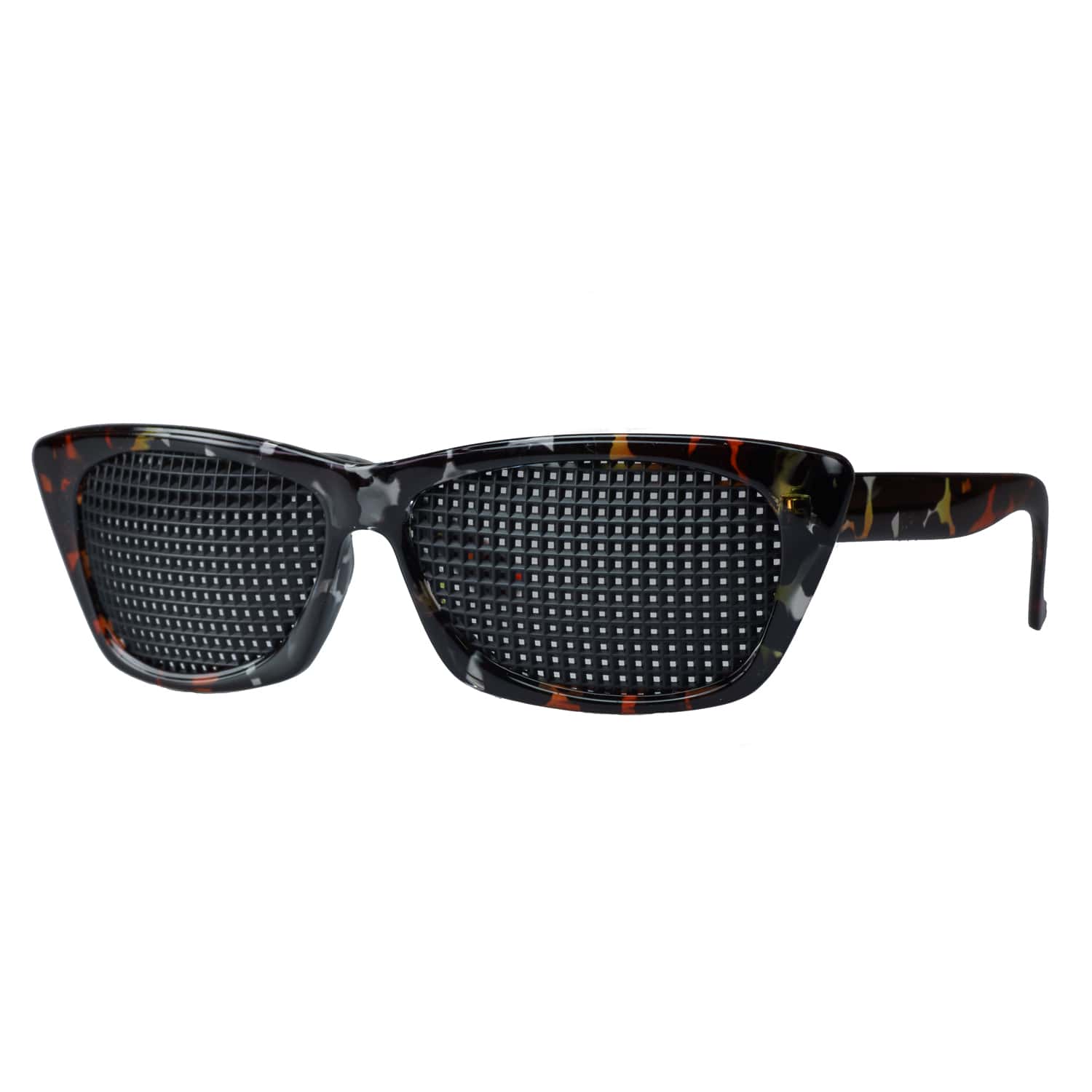
Average rating of 5 out of 5 stars
DimensionsScope of deliveryFrame width: 140 mmPinhole GlassesTemple length: 130 mmGlasses caseBridge width: 15 mmOriginal Visus eye chart, the ideal aid for monitoring the progress of your eye trainingWeight: 21 gDetailed description of glassesGrid height: 40 mmGrid length: 70 mmGrid: pyramidal grid The curved lenses feature a scratch-resistant, square grid arranged in a pyramid shape. This full-surface grid is preferred for prescriptions under 2.0 dioptres and is used by non-spectacle wearers for prevention. Use: For targeted vision training, wear the Pinhole Glasses or multidot glasses for 10–20 minutes every day. Ideal for routine tasks at home or at work. People with long-sightedness use the glasses for close-up work, e.g. reading, while people with short-sightedness activate their eyes when watching television, working at a screen or going for walks. Benefits: Thanks to the pinhole effect, the glasses enable almost sharp vision, while the brain activates the eye muscles, thus reactivating natural vision. In contrast to conventional glasses, the muscles remain active and trained. Design: The stylish, brown-tigered model impresses with a feminine design that tapers off at the top of the frame and a solid frame. The workmanship ensures high wearing comfort and at the same time makes the glasses an attractive fashion accessory. Maintaining eye health in our hectic times Traditional vision exercises are time-consuming and require discipline. Training with pinhole glasses supports modern ‘multitasking’: you can complete your daily vision training while working on the computer or performing routine tasks. Eye training – an intelligent alternative for visual impairments In today's working world, the eyes are often subjected to one-sided strain, both in terms of light-dark adjustments and near-far changes. Training with pinhole glasses breaks through this one-sidedness and promotes natural vision. The origin of eye training according to William Bates William Bates proved that visual acuity depends not only on the lens of the eye, but also on the activity of the six external eye muscles. In 1920, he published his findings in ‘Perfect Sight Without Glasses’. His method is based on simple eye exercises, which were later expanded upon by vision trainer Janet Goodrich and investigated in studies on grid and pinhole glasses. Additional product information: Manufacturer: BioTec Dr. Egely & Lobmayer GmbH, Sendlingerstr. 8, 84332 Hebertsfelden, Germany, Telephone: +49 8721 910939, Email: info@biotec7.de Warnings and safety instructions: Do not use in road traffic. Improper cleaning or aggressive cleaning agents can damage the glasses.

DimensionsScope of deliveryFrame width: 140 mmPinhole GlassesArm length: 140 mmSpectacle caseBridge width: 17 mmOriginal Visus eye chart, the ideal aid for monitoring the progress of your eye trainingWeight: 14 gDetailed spectacle descriptionRaster height: 35 mmGrid length: 55 mm Grid: conventional round pinhole grid The curved lenses have a large, round grid. This allows a particularly large amount of light to enter the eye. This type of grid is suitable for almost all users and is often worn for preventive purposes. Use Train your eyes for 10–20 minutes every day with Pinhole Glasses (also known as multidot glasses). Use them regularly for everyday tasks at home and at work: For long-sightedness: ideal for reading For short-sightedness: training for distance vision, e.g. when watching television Benefits Training with pinhole glasses is a holistic method for promoting relaxed and natural vision. Thanks to the physical pinhole effect, the image is perceived almost as sharply as with classic glasses. The background: when wearing pinhole glasses, the brain releases light impulses that activate the eye muscles and thus support focusing. Design Modern plastic frame in a slightly rectangular shape, high-quality finish with a black-blue colour gradient and two fine metal decorations on the outer frame. A durable spring hinge ensures optimal adjustment to the size of the head. Maintaining eye health in our hectic times Classic vision exercises require a lot of time and discipline to strengthen vision in the long term. Training with grid or pinhole glasses, on the other hand, is perfect for modern multitasking. You can train your eyes while performing activities such as computer work. Eye training with pinhole glasses – an intelligent alternative for visual impairments In our complex working world, our eyes are often subjected to one-sided strain: Adaptation: problems with light-dark adjustment Accommodation: Difficulties switching between near and far vision These stresses often lead to declining vision or the development of vision problems. Training with pinhole glasses breaks through this one-sidedness – the eye learns to see naturally again. The origins of eye training according to William Bates William Bates, the founder of modern eye training, demonstrated through numerous experiments that vision can be restored. He discovered that it is not the lens, but the outer six eye muscles that are responsible for focusing. In 1920, he published his findings in the classic Perfect Sight Without Glasses. Building on this, he developed simple exercises for different vision problems – known as the Bates Method. Later, Janet Goodrich, one of the leading vision trainers, took up this method and published the first studies on the effect of pinhole glasses. Additional product information Manufacturer: BioTec Dr. Egely & Lobmayer GmbH Sendlingerstr. 8, 84332 Hebertsfelden, Germany Telephone: +49 8721 910939 Email: info@biotec7.de Warnings and safety instructions Not suitable for road traffic. Do not use aggressive cleaning agents, as improper care can damage the glasses.
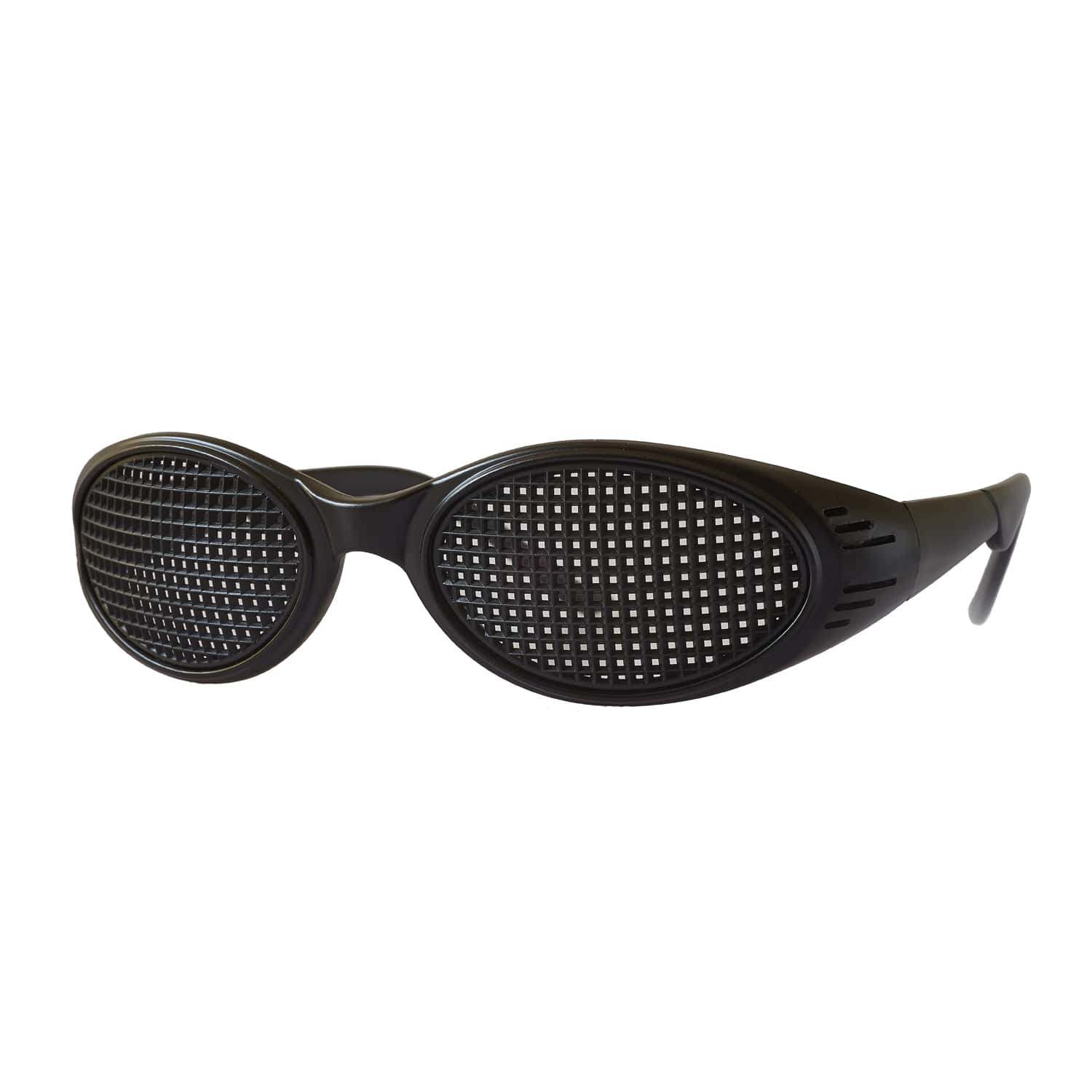
DimensionsScope of deliveryFrame width: 140 mmPinhole GlassesArm length: 115 mmSpectacle caseBridge width: 20 mmOriginal Visus eye chart, the ideal aid for monitoring the progress of your eye trainingWeight: 20 gDetailed spectacle descriptionRaster height: 35 mmGrid length: 55 mmGrid: pyramidal grid A scratch-resistant, square grid arranged in a pyramid shape is integrated into curved lenses. Experience shows that this grid is preferred for prescriptions under 2.0 dioptres and serves as prevention for non-spectacle wearers. Use: Use the Pinhole Glasses or multidot glasses for 10–20 minutes every day. Long-sighted people wear them when reading, short-sighted people when watching television, using a computer screen or during activities that require distance vision. Benefits: Training with Pinhole Glasses supports natural vision. Thanks to the pinhole effect, you can see almost as clearly as with corrective glasses. At the same time, the brain activates the eye muscles, allowing sharpness to be achieved independently. Design: The black, slim-fit frames for men and women make a fashionable, sporty statement. Side light protection ensures optimal training sessions with the Multidot glasses. Maintaining eye health in our hectic times Traditional vision exercises are time-consuming and require disciplined practice. Training with grid or pinhole glasses is ideal for modern multitasking – you train your eyes while working on the computer, for example. Eye training – an intelligent alternative for visual impairments Modern working environments place a one-sided strain on the eyes – both in terms of light-dark adaptation and near-far focusing. Vision training with pinhole glasses breaks through this one-sidedness and supports natural vision. The origin of eye training according to William Bates William Bates proved that visual acuity does not primarily depend on the lens of the eye, but on the activity of the six external eye muscles. In 1920, he published his findings in ‘Perfect Sight Without Glasses’. Later, Janet Goodrich developed training methods for grid and pinhole glasses based on these findings. Additional product information: Manufacturer: BioTec Dr. Egely & Lobmayer GmbH, Sendlingerstr. 8, 84332 Hebertsfelden, Germany, Telephone: +49 8721 910939, Email: info@biotec7.de Warnings and safety instructions: Do not use in road traffic. Improper cleaning or aggressive cleaning agents can damage the glasses.
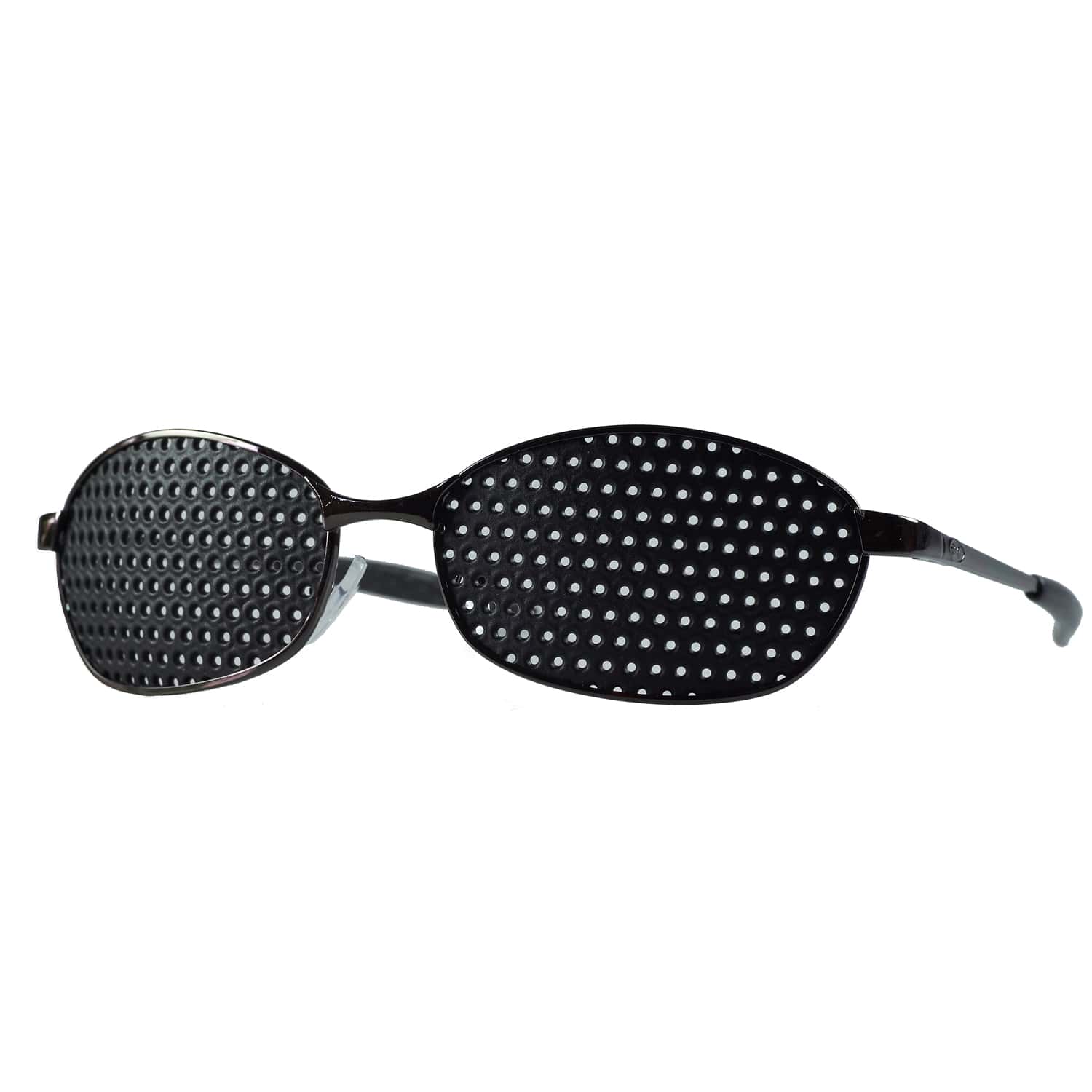
DimensionsScope of deliveryFrame width: 140 mmPinhole GlassesTemple length: 130 mmGlasses caseBridge width: 18 mmOriginal Visus eye chart, the ideal aid for monitoring the progress of your eye trainingWeight: 20 gDetailed description of glassesRaster height: 35 mmGrid length: 58 mmGrid: classic round hole grid The curved lenses feature a full-surface, coarser round grid that allows for maximum light incidence. This type of grid is suitable for everyone and is also worn prophylactically. Application 10–20 minutes of daily vision training with Pinhole Glasses or multidot glasses. Wear them during everyday activities at home or at work. Long-sighted people: supports near vision, e.g. when reading Short-sighted people: promotes distance vision when watching television, working at a screen or going for walks Advantages The pinhole glasses are based on the physical pinhole effect. They enable almost sharp vision without optical lenses, while the brain activates the eye muscles. This specifically trains the natural visual function. Design & comfort The silver-anodised metal frame in optician quality is suitable for both women and men. The curved side screens protect the eyes from scattered light. Soft silicone nose pads and reinforced plastic ends ensure a high level of comfort. Eye health in everyday life Traditional vision exercises are time-consuming and require discipline. Training with grid or pinhole glasses fits perfectly into modern everyday life: you train your eyes while working on the computer, for example. Intelligent vision training In the modern working world, our eyes are often subjected to one-sided strain: Adaptation: problems with light-dark adjustments Accommodation: difficulties switching between near and distant vision Training with pinhole glasses breaks through this one-sidedness and promotes natural, active vision. The eye learns to focus independently again. Origin according to William Bates William Bates proved that visual acuity does not depend on the lens of the eye, but on the six external eye muscles. In 1920, he published his classic work Perfect Sight Without Glasses and developed the well-known Bates method. Later, Janet Goodrich built on this and published the first studies on grid and pinhole glasses. Product information Manufacturer: BioTec Dr. Egely & Lobmayer GmbH Sendlingerstr. 8, 84332 Hebertsfelden, Germany Telephone: +49 8721 910939 Email: info@biotec7.de Safety and warning information The glasses must not be used in road traffic. Clean only with mild cleaning agents – aggressive agents or improper handling can damage the glasses.

DimensionsScope of deliveryFrame width: 140 mmPinhole GlassesTemple length: 145 mmSpectacle caseBridge width: 20 mmOriginal Visus eye chart, the ideal aid for monitoring the progress of your eye trainingWeight: 15 gDetailed spectacle descriptionRaster height: 40 mmGrid length: 50 mmGrid: pyramidal grid The curved lenses feature a scratch-resistant, square grid arranged in a pyramid shape. This full-surface grid is preferred for prescriptions under 2.0 dioptres and is particularly suitable for people who do not wear glasses as a preventive measure. Use: For effective eye training, wear the Pinhole Glasses or multidot glasses for 10–20 minutes every day. Integrate them into your everyday activities at home or at work. People who are long-sighted benefit when reading, while those who are short-sighted train their eyes when watching television or looking into the distance, for example during a walk. Benefits: The pinhole glasses train the eye in a natural way. The pinhole effect creates almost sharp vision, while the brain stimulates the eye muscles to adjust the focus independently again. This keeps the muscles active and flexible. Design: The silver-coloured spectacle frame in a classic panto style – oval at the top, round at the bottom – combines durability with minimal weight (only 15 g). Silicone nose pads and plastic reinforcements at the ends of the arms ensure high wearing comfort without pressure points. Unisex design with a striking nose bridge. Maintaining eye health in our hectic times Traditional vision exercises require a lot of time and discipline. Training with pinhole glasses supports modern multitasking: you can complete your daily vision training while working on the computer or performing routine tasks. Eye training – an intelligent alternative for visual impairments In the modern working world, our eyes are often subjected to one-sided strain, whether it be adjusting to light and dark or switching between near and far vision. Training with pinhole glasses breaks through this one-sidedness and promotes natural vision. The origins of eye training according to William Bates William Bates proved through numerous experiments that visual acuity does not primarily depend on the lens of the eye, but on the activity of the six external eye muscles. In 1920, he published his findings in ‘Perfect Sight Without Glasses’. The Bates method developed from this forms the basis for training with pinhole glasses. Later, vision trainer Janet Goodrich expanded on the method and published studies on pinhole and pinhole glasses. Additional product information: Manufacturer: BioTec Dr. Egely & Lobmayer GmbH, Sendlingerstr. 8, 84332 Hebertsfelden, Germany, Telephone: +49 8721 910939, Email: info@biotec7.de Warnings and safety instructions: Do not use in road traffic. Aggressive cleaning agents or improper handling may damage the glasses.
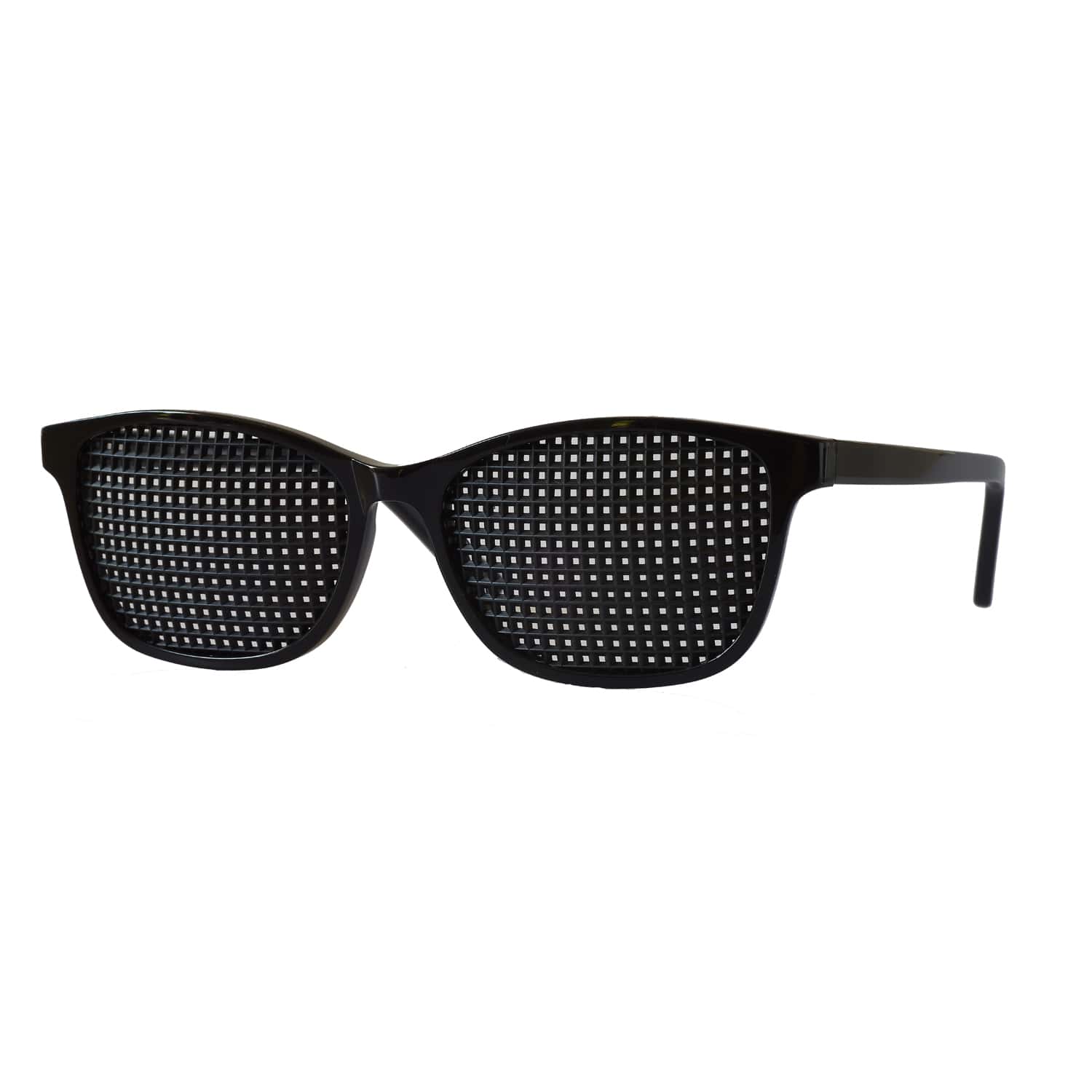
DimensionsScope of deliveryFrame width: 130 mmPinhole GlassesArm length: 140 mmSpectacle caseBridge width: 15 mmOriginal Visus eye chart, the ideal aid for monitoring the progress of your eye trainingWeight: 20 gDetailed spectacle descriptionRaster height: 35 mmGrid length: 53 mmFirst pinhole glasses made from organic materials Design The first pinhole glasses made from organic materials! Sustainably manufactured using traditional craftsmanship, they combine the highest standards of quality and comfort. Permanently dimensionally stable Easy to clean Insensitive to moisture and temperature fluctuations Advantages over conventional glasses Very lightweight Silky sheen Optimal comfort without pressure points on the bridge of the nose Environmentally friendly, recyclable material Easy to repair Grid Pyramid-shaped, scratch-resistant, square grid on curved lenses. Experience shows: This full-surface grid is preferred for prescriptions below 2.0 dioptres and serves as a preventive measure for people who do not wear spectacles. Use For effective eye training: practise for 10–20 minutes daily with the grid or Multidot glasses. Ideal during everyday activities: Long-sighted people: while reading Short-sighted people: while watching television, working at a computer screen or walking in the distance Benefits The physical pinhole effect supports clear vision. The brain activates the eye muscles to focus independently – a function that normal glasses often do not train. Design Purist unisex design with durable metal spring hinges. The velvety-silky sheen of the black frame combines aesthetics with environmental awareness. Eye health in everyday life Traditional vision exercises are time-consuming and require discipline. Pinhole glasses enable effective training alongside everyday tasks such as working on the computer. Intelligent vision training Modern working conditions place a one-sided strain on the eyes: Adaptation performance: light-dark adjustment Accommodation performance: near-far focusing The pinhole glasses break through this one-sided strain and promote natural, active vision. Origin of eye training according to William Bates William Bates proved that visual acuity depends on the activity of the six external eye muscles, not on the eye lens. In 1920, he published Perfect Sight Without Glasses and developed the Bates Method. Later, Janet Goodrich built on this and published the first studies on grid and pinhole glasses. Product information Manufacturer: BioTec Dr. Egely & Lobmayer GmbH Sendlingerstr. 8, 84332 Hebertsfelden, Germany Telephone: +49 8721 910939 Email: info@biotec7.de Safety and warning information The glasses must not be worn in road traffic. Clean only with mild cleaning agents. Aggressive agents or improper handling can damage the glasses.

Dimensions Scope of delivery Frame width: 140 mm Pinhole Glasses Temple length: 140 mm Glasses case Bridge width: 17 mm Original Visus eye chart, the ideal aid for monitoring the progress of your eye training Weight: 14 g Detailed description of glasses Grid height: 35 mm Grid length: 55 mm Grid: Bifocal dot grid With this type of grid, the dot grid in the upper viewing area of the curved lenses is smaller and denser, while in the lower viewing area it becomes larger and coarser. This enables a dynamic change in ‘focusing’ between relaxing (small holes) and training. Many years of experience show that this type of grid is preferred by people with more than 3.0 dioptres. Use: 10 to 20 minutes of daily training with the Pinhole Glasses. Wear them regularly during your usual activities at home and at work. If you are long-sighted, use the glasses for close-up work, e.g. when reading. If you are short-sighted, let your eyes “jog” with the pinhole glasses – also called multidot glasses – when watching television, looking at a screen or going for a walk. Benefits: The pinhole glasses provide soothing relief for the eyes thanks to the pinhole effect. While vision remains almost sharp, the brain begins to encourage the muscles of the eye to focus naturally – the eye remains mobile and active. Design: High-quality plastic frame in a slightly rectangular shape with a trendy black-blue colour gradient and two delicate metal decorations on the outer frame. A durable spring hinge adapts perfectly to the size of the head. Maintaining eye health in our hectic times Traditional vision exercises to strengthen eyesight are time-consuming and require disciplined practice to compensate for visual impairments in the long term. Training with pinhole glasses is in line with modern ‘multitasking’. You complete your daily training and can do your work on the computer, for example, at the same time. Eye training with pinhole glasses – an intelligent alternative for visual impairments In today's modern and complex working world, our eyes are exposed to one-sided strain on the adaptation capacity (problems with light-dark adjustment) and the one-sided strain on the accommodation capacity (problems with near-far adjustment). These are usually the cause of declining vision or the development of vision problems. Vision training with pinhole glasses ‘breaks through’ this one-sidedness of vision. The eye learns to see naturally again. The origin of eye training according to William Bates William Bates, the forefather of eye training, proved that vision can be retrained through numerous experiments. According to his findings, it was not the lens of the eye that was responsible for ‘focusing’ and/or visual acuity, but rather the activity of the six external six eye muscles. In 1920, he published his empirical findings in his classic work ‘Perfect Sight Without Glasses’. Based on his theory, Bates developed simple eye exercises for various visual impairments. This is known as the ‘Bates method’. Later, the luminary among vision trainers Janet Goodrich built on the Bates Method and published the first studies on pinhole glasses or pinhole glasses. Additional product information: Manufacturer: BioTec Dr. Egely & Lobmayer GmbH, Sendlingerstr. 8, 84332 Hebertsfelden, Germany, Telephone: +49 8721 910939, Email: info@biotec7.de Warnings and safety instructions: Must not be used in road traffic. Inappropriate cleaning: The use of aggressive cleaning agents or improper handling can damage the glasses.

DimensionsScope of deliveryFrame width: 135 mmPinhole GlassesTemple length: 140 mmSpectacle caseBridge width: 15 mmOriginal Visus eye chart, the ideal aid for monitoring the progress of your eye trainingWeight: 22 gDetailed spectacle descriptionRaster height: 40 mmGrid length: 70 mmGrid: pyramidal grid The curved lenses contain a scratch-resistant, square grid arranged in a pyramid shape. This full-surface grid is preferred for prescriptions under 2.0 dioptres and serves as a preventative measure for people who do not wear glasses. Use: The Pinhole Glasses or multidot glasses should be worn for 10–20 minutes a day during normal activities. Long-sighted people benefit when reading, while short-sighted people activate their vision when watching television, working at a computer screen or looking into the distance. Benefits: Pinhole Glasses support natural vision training. The pinhole effect enables almost sharp vision, while the brain stimulates the eye muscles so that the eye can focus independently again. Design: The shiny black plastic frame with silver-coloured decorative rivets at the top of the frame impresses with its high-quality workmanship. The model is unisex, offers high wearing comfort and gives the glasses an elegant look. Maintaining eye health in hectic times Traditional vision exercises are often time-consuming and require discipline. With pinhole glasses, training can be easily integrated into everyday life, e.g. while working on the computer. Eye training – an intelligent alternative for visual impairments Modern working environments place a one-sided strain on the eyes' ability to adapt and accommodate. Training with pinhole glasses breaks this one-sidedness and promotes natural vision. The origin of eye training according to William Bates William Bates proved that visual acuity is significantly influenced by the activity of the six external eye muscles. In 1920, he published his findings in ‘Perfect Sight Without Glasses’. The methods were further developed by Janet Goodrich and scientifically applied to grid and pinhole glasses. Additional product information: Manufacturer: BioTec Dr. Egely & Lobmayer GmbH, Sendlingerstr. 8, 84332 Hebertsfelden, Germany, Telephone: +49 8721 910939, Email: info@biotec7.de Warnings and safety instructions: Do not use in road traffic. Improper cleaning or aggressive cleaning agents can damage the glasses.

DimensionsScope of deliveryFrame width: 145 mmPinhole GlassesTemple length: 135 mmGlasses caseBridge width: 16 mmOriginal Visus eye chart, the ideal aid for monitoring the progress of your eye trainingWeight: 16 gDetailed description of glassesGrid height: 35 mmGrid length: 55 mmGrid: pyramidal grid The curved lenses have a scratch-resistant, square grid arranged in a pyramid shape. This grid is preferred for prescriptions under 2.0 dioptres and is particularly suitable for people who do not wear glasses as a preventive measure. Use: Daily training with Pinhole Glasses or multidot glasses for 10–20 minutes is sufficient. Use the glasses consistently for routine tasks at home or at work. Farsighted people benefit when reading, while nearsighted people can improve their eyesight when watching television or taking walks and looking into the distance. Benefits: Pinhole Glasses offer a holistic training method for the eyes. The physical pinhole effect enables almost sharp vision, while the brain stimulates the eye muscles to actively focus – without the need for optical lenses. Design: The silver-coloured frame combines straight lines in the upper viewing area with slightly rounded ends. It impresses with its robustness and high wearing comfort. Unisex, with reinforced plastic ends and silicone nose pads for optimal fit. Eye health in our hectic times Traditional vision exercises are time-consuming and require consistent training. Pinhole glasses support effective vision training during modern multitasking activities – e.g. when working on a computer. Eye training – an intelligent alternative for visual impairments In the modern working world, eyes are often exposed to one-sided strain – whether it's adjusting to light and dark or switching between near and far vision. Training with pinhole glasses breaks through this one-sidedness and promotes natural vision. The origin according to William Bates: William Bates demonstrated through numerous experiments that visual acuity depends primarily not on the lens of the eye, but on the activity of the six external eye muscles. In 1920, he published his findings in ‘Perfect Sight Without Glasses’. The Bates method developed from this forms the basis for training with pinhole glasses. Later, vision trainer Janet Goodrich expanded on the method and published studies on pinhole glasses. Additional product information: Manufacturer: BioTec Dr. Egely & Lobmayer GmbH, Sendlingerstr. 8, 84332 Hebertsfelden, Germany, Telephone: +49 8721 910939, Email: info@biotec7.de Warnings and safety instructions: Do not use in road traffic. Aggressive cleaning agents or improper handling can damage the glasses.

DimensionsScope of deliveryFrame width: 130 mmPinhole GlassesTemple length: 135 mmSpectacle caseBridge width: 16 mmOriginal Visus eye chart, the ideal aid for monitoring the progress of your eye trainingWeight: 18 gDetailed spectacle descriptionRaster height: 40 mmGrid length: 50 mmGrid: pyramidal grid The curved lenses feature a scratch-resistant, square grid arranged in a pyramid shape. This full-surface grid is preferred for prescriptions under 2.0 dioptres and is particularly suitable for people who do not wear glasses as a preventive measure. Use: For targeted eye training, wear the Pinhole Glasses or multidot glasses for 10–20 minutes every day. Ideal for everyday activities at home or at work. Long-sighted people use the glasses when reading, while short-sighted people use them to improve their eyesight when working at a computer screen, watching television or going for walks. Benefits: The pinhole glasses support vision in a natural way. The pinhole effect creates almost sharp vision, while the brain activates the eye muscles to adjust the focus independently. This trains the muscles instead of passively relieving them. Design: The high-quality, gold-coloured metal frame impresses with its elegance and comfort. Silicone nose pads and reinforced plastic ends ensure a comfortable fit, suitable for both men and women. Maintaining eye health in our hectic times Traditional vision exercises are time-consuming and require discipline. Pinhole glasses enable modern vision training while multitasking: you can complete your daily training while working on the computer or doing routine tasks, for example. Eye training – an intelligent alternative for visual impairments In the modern working world, our eyes are often subjected to one-sided strain, whether it be adjusting to light and dark or switching between near and distant vision. Training with pinhole glasses breaks through this one-sidedness and promotes natural vision. The origin of eye training according to William Bates William Bates proved through numerous experiments that visual acuity does not primarily depend on the lens of the eye, but on the activity of the six external eye muscles. In 1920, he published his findings in ‘Perfect Sight Without Glasses’. The Bates method developed from this forms the basis for training with pinhole glasses. Later, vision trainer Janet Goodrich expanded on the method and published studies on pinhole and pinhole glasses. Additional product information: Manufacturer: BioTec Dr. Egely & Lobmayer GmbH, Sendlingerstr. 8, 84332 Hebertsfelden, Germany, Telephone: +49 8721 910939, Email: info@biotec7.de Warnings and safety instructions: Do not use in road traffic. Aggressive cleaning agents or improper handling may damage the glasses.
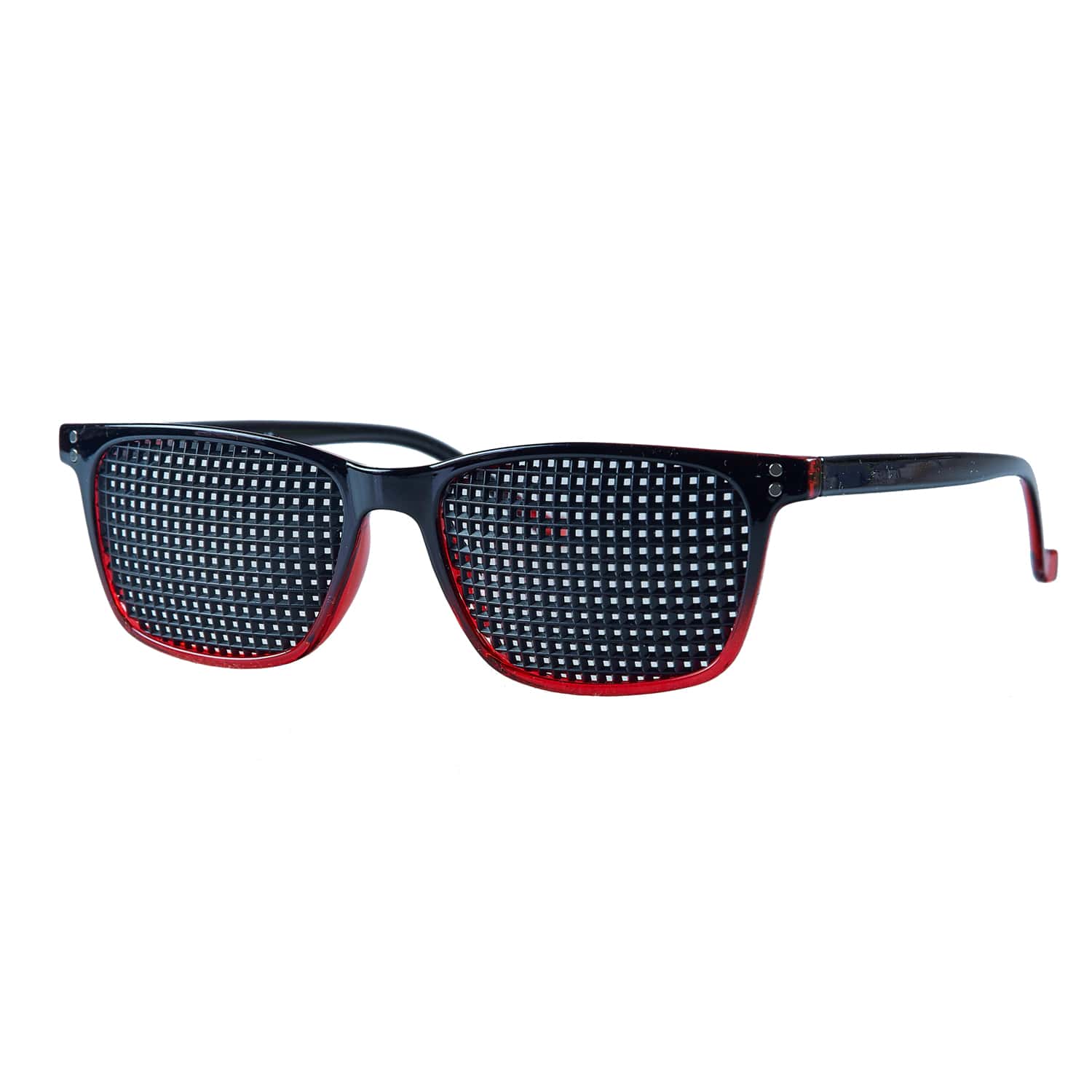
DimensionsScope of deliveryFrame width: 140 mmPinhole GlassesTemple length: 140 mmSpectacle caseBridge width: 17 mmOriginal Visus eye chart, the ideal aid for monitoring the progress of your eye trainingWeight: 14 gDetailed spectacle descriptionRaster height: 35 mmGrid length: 55 mmGrid: pyramidal grid The curved lenses have a scratch-resistant, square grid arranged in a pyramid shape. This grid is preferred for prescriptions under 2.0 dioptres and is particularly suitable for people who do not wear glasses as a preventive measure. Use: Train your eyes for 10–20 minutes every day with pinhole glasses. Ideal for all everyday activities at home and at work. For long-sighted people, they support close-up vision, for example when reading. Short-sighted people can keep their eyes active when watching television, working at a screen or looking into the distance, e.g. with multidot glasses. Benefits: Thanks to the pinhole effect, Pinhole Glasses enable almost sharp vision, while the eye muscles are activated by neural stimuli. This keeps the eye muscles active and strong, in contrast to the passive relief provided by conventional glasses. Design: Slightly rectangular plastic frame with high-quality workmanship and an elegant black and reddish color gradient. Two delicate metal decorations on the outer frame and a durable spring hinge ensure optimal adjustment to any head size. Eye health in modern times: Traditional vision exercises are often time-consuming and require consistent training. Pinhole glasses enable effective vision training during modern multitasking activities – e.g. when working on a computer. Eye training: a smart alternative for vision problems Our eyes are often overstrained by one-sided strain in the modern working world – whether it's adjusting to light and dark situations or switching between near and far vision. Raster glasses training breaks through this one-sidedness and supports natural vision. The origin according to William Bates: William Bates proved through numerous experiments that visual acuity does not primarily depend on the lens of the eye, but on the activity of the six external eye muscles. In 1920, he published his findings in ‘Perfect Sight Without Glasses’. The Bates method developed from this forms the basis for training with pinhole glasses. Later, vision trainer Janet Goodrich expanded on the method and published studies on pinhole glasses. Additional product information: Manufacturer: BioTec Dr. Egely & Lobmayer GmbH, Sendlingerstr. 8, 84332 Hebertsfelden, Germany, Telephone: +49 8721 910939, Email: info@biotec7.de Warnings and safety instructions: Do not use in road traffic. Aggressive cleaning agents or improper handling can damage the glasses.
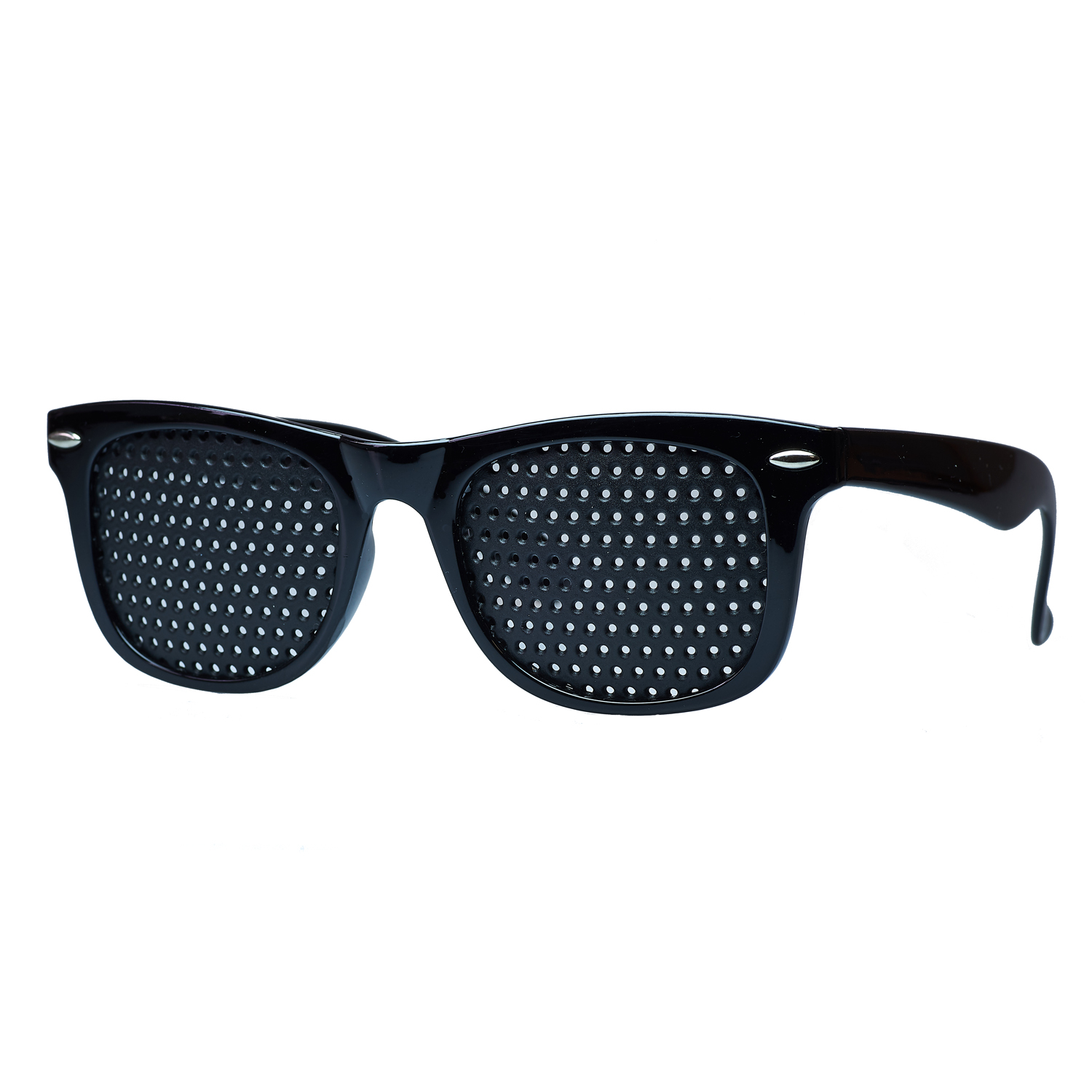
DimensionsScope of deliveryFrame width: 135 mmPinhole GlassesTemple length: 140 mmGlasses caseBridge width: 15 mmOriginal Visus eye chart, the ideal aid for monitoring the progress of your eye trainingWeight: 22 gDetailed description of glassesRaster height: 40 mmGrid length: 70 mmGrid: classic round hole grid The curved lenses feature a full-surface, coarser round grid, thus offering the greatest light incidence. This type of grid is suitable for everyone and can also be worn prophylactically. Application Daily training with Pinhole Glasses or multidot glasses for 10–20 minutes. Integrate the glasses into your routine tasks at home or at work: Long-sighted people: when reading Short-sighted people: when looking into the distance, e.g. when watching television or going for a walk Benefits The pinhole glasses activate the eye in a natural way. The pinhole effect creates almost clear vision, while the brain stimulates the eye muscles to focus independently – in contrast to the passive effect of conventional glasses. Design & style The expressive shiny black plastic frame is embellished with silver-coloured decorative rivets on the upper frame. Suitable for both men and women, the glasses impress with their high-quality comfort and elegant look. Eye health in everyday life Traditional vision exercises are time-consuming and require discipline. Training with grid or pinhole glasses fits perfectly into modern everyday life: you train your eyes while working on the computer, for example. Intelligent vision training Our eyes are often strained on one side: Adaptation: problems with light-dark adjustments Accommodation: difficulties switching between near and distant vision Training with pinhole glasses breaks through this one-sidedness and promotes active, natural vision. Origin according to William Bates William Bates showed that visual acuity does not depend on the lens of the eye, but on the six external eye muscles. In 1920, he published Perfect Sight Without Glasses and developed the Bates Method. Later, Janet Goodrich built on this and published studies on grid and pinhole glasses. Product information Manufacturer: BioTec Dr. Egely & Lobmayer GmbH Sendlingerstr. 8, 84332 Hebertsfelden, Germany Telephone: +49 8721 910939 Email: info@biotec7.de Safety and warning information The glasses must not be used in road traffic. Clean only with mild cleaning agents – aggressive agents or improper handling can damage the glasses.

Dimensions Scope of delivery Frame width: 140 mm Pinhole Glasses Temple length: 120 mm Spectacle case Bridge width: 15 mm Original Visus eye chart, the ideal aid for monitoring the progress of your eye training Weight: 23 g Detailed description of glasses Grid height: 40 mm Grid length: 50 mm Grid: Bifocal dot grid With this type of grid, the dot grid in the upper viewing area of the curved lenses is smaller and denser, while in the lower viewing area it becomes larger and coarser. This enables a dynamic change in ‘focusing’ between relaxation (small holes) and training. Many years of experience show that this type of grid is preferred by people with more than 3.0 dioptres. Use: Daily Pinhole Glasses training for 10 to 20 minutes. Integrate the glasses into your daily home or work routines. For long-sightedness, they help with reading, and for short-sightedness, they help with relaxed distance vision – e.g. when out walking. Benefits: Pinhole glasses provide active training for the eye. The pinhole effect provides a clear image, and the muscles remain mobile thanks to impulses from the brain – in contrast to corrective glasses, which relieve and weaken the eye. Design: The robust black matt panto-style frame is slightly oval at the top and rounded at the bottom. This model is characterised by high-quality features: spring hinges that adapt perfectly to all face sizes for both men and women. The side shielding is advantageous, preventing distracting light from entering during training. Maintaining eye health in our hectic times Traditional vision exercises to strengthen eyesight are time-consuming and require disciplined practice to compensate for visual impairments in the long term. Training with pinhole glasses or pinhole glasses is well suited to modern ‘multitasking’. You can complete your daily training while working on the computer, for example. Eye training with pinhole glasses – an intelligent alternative for visual impairments In the modern working world, our eyes are exposed to one-sided strain: adaptation (problems with light-dark adjustment) and accommodation (problems with near-far adjustment). This often leads to declining vision. Vision training with pinhole glasses breaks through this one-sidedness of vision. The eye learns to see naturally again. The origin of eye training according to William Bates William Bates, the forefather of eye training, proved through numerous experiments that vision can be retrained. It is not the lens of the eye that is responsible for ‘focusing’ and visual acuity , but the activity of the six external eye muscles. In 1920, he published his empirical findings in his classic work ‘Perfect Sight Without Glasses’. Bates developed simple eye exercises for various visual impairments, known as the Bates method. Later, Janet Goodrich built on this method and published the first studies on grid and pinhole glasses. Additional product information: Manufacturer: BioTec Dr. Egely & Lobmayer GmbH, Sendlingerstr. 8, 84332 Hebertsfelden, Germany, Telephone: +49 8721 910939, Email: info@biotec7.de Warnings and safety instructions: Must not be used in road traffic. Improper cleaning or aggressive cleaning agents can damage the glasses.

Dimensions Scope of delivery Frame width: 140 mm Pinhole glasses Temple length: 130 mm Glasses case Bridge width: 15 mm Original Visus eye chart – the ideal aid for monitoring the progress of your eye training Weight: 21 g Detailed description of glasses Grid height: 40 mm Grid length: 70 mm Grid: Bifocal dot grid With this type of grid, the dot grid in the upper viewing area of the curved lenses is smaller and denser, while in the lower viewing area it becomes larger and coarser. This enables a dynamic change in focus between relaxation (small holes) and training. Many years of experience show that this type of grid is preferred by people with more than 3.0 dioptres. Use: Wear the Pinhole Glasses or Multidot Glasses for 10–20 minutes every day. Use them during your normal domestic or professional activities. If you are long-sighted, use the glasses for reading; if you are short-sighted, use them for distance vision, e.g., when watching television. Benefits: The pinhole glasses stimulate natural vision through the pinhole effect. When worn, the eye muscles are activated by light signals from the brain – the eye remains mobile, the retina is relieved, and overall vision benefits. Design: The solid workmanship of these stylish, rather feminine glasses with a shiny black, angular upper frame and solid rims fulfils all the requirements for good wearing comfort and a solid yet attractive fashion accessory. Maintaining eye health in our hectic times Traditional eye exercises to strengthen vision are time-consuming and require disciplined practice to compensate for visual impairments in the long term. Training with pinhole glasses or grid glasses is well suited to modern ‘multitasking’. You can complete your daily training while doing other things, such as working on the computer. Eye training with pinhole glasses – an intelligent alternative for visual impairments In the modern and complex world of work, our eyes are exposed to one-sided strain on their adaptive capacity (problems with light-dark adjustment) and one-sided strain on their accommodative capacity (problems with near-far adjustment). These are usually the cause of declining vision or the development of vision problems. Vision training with pinhole glasses ‘breaks through’ this one-sidedness of vision. The eye learns to see naturally again. The origin of eye training according to William Bates William Bates, the forefather of eye training, proved through numerous experiments that vision can be retrained. According to his findings, it was not the lens of the eye that was responsible for ‘focusing’ and/or visual acuity, but rather the activity of the six external eye muscles. In 1920, he published his empirical findings in his classic work ‘Perfect Sight Without Glasses’. Based on his theory, Bates developed simple eye exercises for various visual impairments, known as the Bates Method. Later, the luminary among vision trainers, Janet Goodrich, built on the Bates Method and published the first studies on pinhole glasses or grid glasses. Additional product information: Manufacturer: BioTec Dr. Egely & Lobmayer GmbH, Sendlingerstr. 8, 84332 Hebertsfelden, Germany, Telephone: +49 8721 910939, Email: info@biotec7.de Warnings and safety instructions: Must not be used in road traffic. Unsuitable cleaning: The use of aggressive cleaning agents or improper handling can damage the glasses.
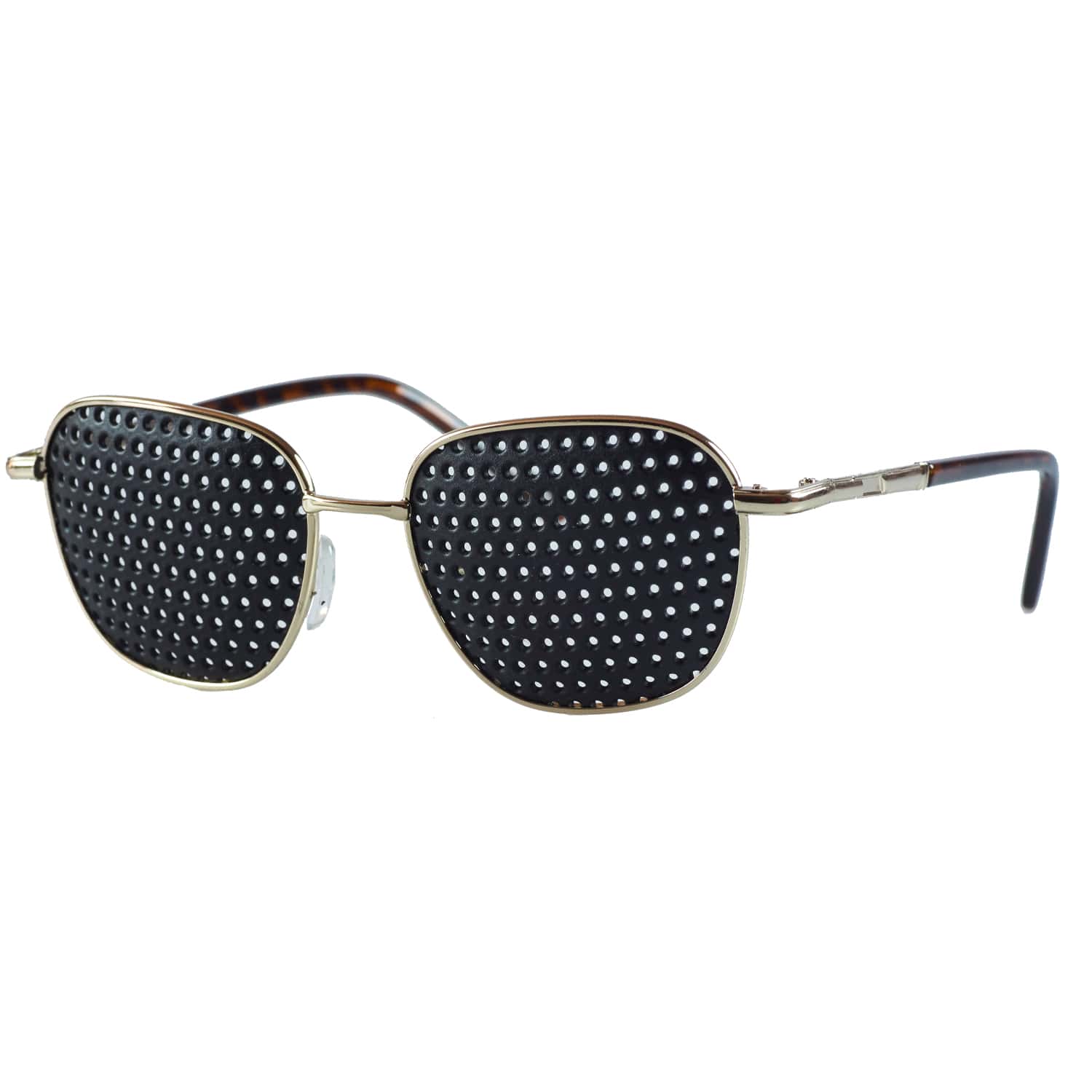
DimensionsScope of deliveryFrame width: 130 mmPinhole GlassesTemple length: 135 mmGlasses caseBridge width: 16 mmOriginal Visus eye chart, the ideal aid for monitoring the progress of your eye trainingWeight: 18 gDetailed description of glassesRaster height: 40 mmGrid length: 50 mmGrid: classic round hole grid The curved lenses have a continuous, coarser round grid. This allows a particularly large amount of light to enter the eye. This type of grid is suitable for almost everyone and is also often used as a precautionary measure. Application Wear the Pinhole Glasses or multidot glasses for about 10 to 20 minutes every day. Incorporate them into your daily activities: Long-sightedness: for reading or close-up work Short-sightedness: when watching television or looking at distant objects Advantages Pinhole Glasses allow you to train your eyes in a natural way. The pinhole effect produces an image that is almost as sharp as that produced by conventional glasses. While corrective glasses take care of the focusing, Pinhole Glasses encourage the eye muscles to work actively themselves. Design Design Elegant frame made of high-quality, gold-coloured metal – suitable for both men and women. Adjustable silicone nose pads and reinforced plastic temple tips ensure excellent wearing comfort. Eye health in modern everyday life Classic vision exercises require a lot of time and perseverance. Effective training with grid or pinhole glasses, on the other hand, is ideal for today's multitasking. This allows you to train your eyes while performing activities such as computer work. Pinhole glasses as a smart alternative for vision problems At work and in everyday life, the eyes are often subjected to one-sided strain: Adaptation: Problems with light-dark adjustment Accommodation: Difficulties switching between near and far vision Such strain often leads to declining vision. Training with pinhole glasses interrupts this one-sided strain and promotes natural vision again. The origins according to William Bates William Bates, the pioneer of modern eye training, was able to show through numerous experiments that vision can be trained. He recognised that it is not the lens, but the six external eye muscles that are responsible for focusing. In 1920, he published his findings in the work Perfect Sight Without Glasses. This formed the basis for the Bates Method, which involves simple exercises to improve vision. Later, Janet Goodrich conducted the first studies on the effect of pinhole glasses and further developed the method. Additional product information Manufacturer: BioTec Dr. Egely & Lobmayer GmbH Sendlingerstr. 8, 84332 Hebertsfelden, Germany Telephone: +49 8721 910939 Email: info@biotec7.de Warnings and safety instructions Not suitable for road traffic. Do not use aggressive cleaning agents, as these can damage the glasses.
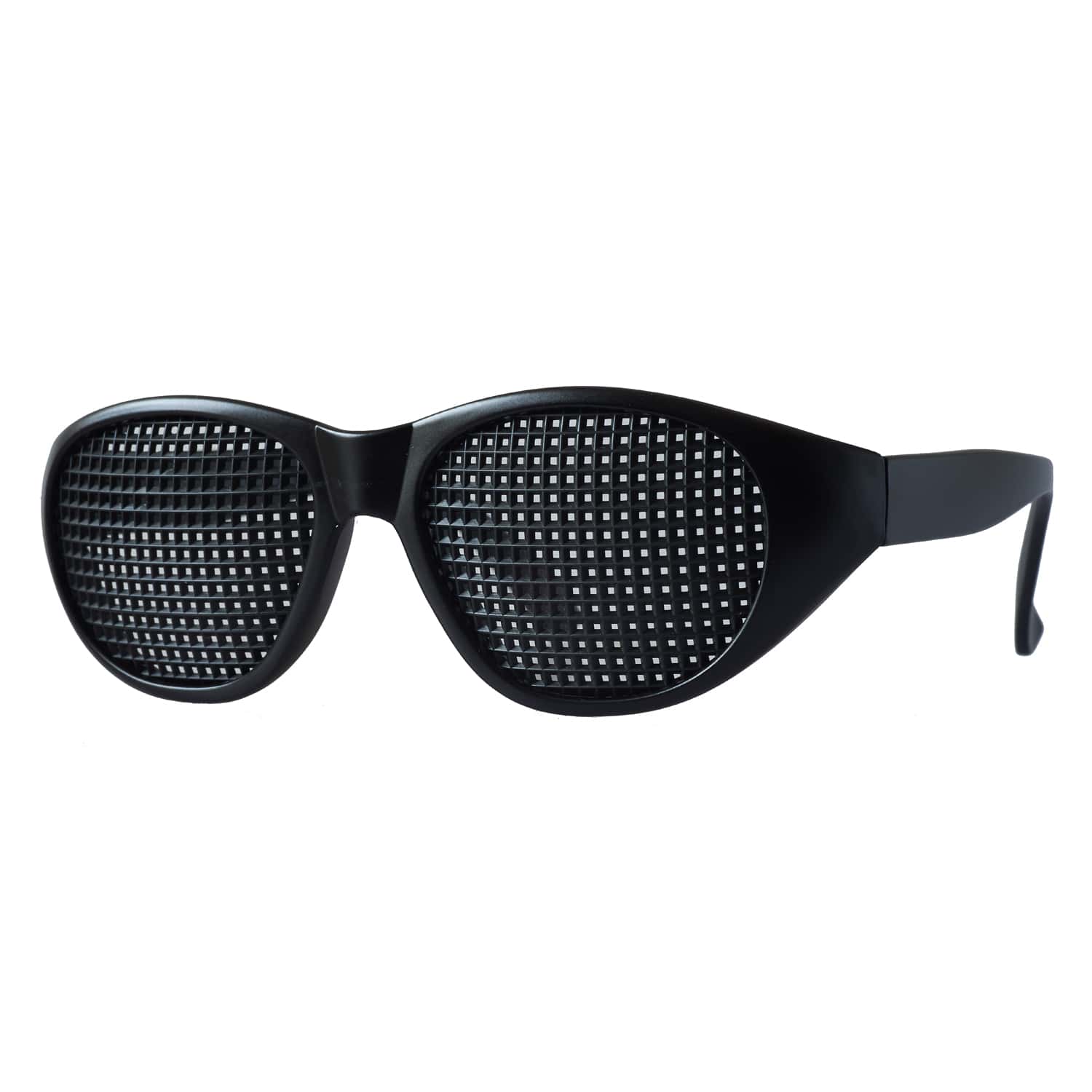
DimensionsScope of deliveryFrame width: 140 mmPinhole GlassesArm length: 120 mmSpectacle caseBridge width: 15 mmOriginal Visus eye chart, the ideal aid for monitoring the progress of your eye trainingWeight: 23 gDetailed spectacle descriptionRaster height: 40 mmGrid length: 50 mmGrid: pyramidal grid The curved lenses feature a scratch-resistant, square grid arranged in a pyramid shape. Experience shows that this grid is preferred for prescriptions under 2.0 dioptres and serves as a preventative measure for people who do not wear glasses. Use: For effective vision training, it is sufficient to wear the Pinhole Glasses or multidot glasses for 10–20 minutes a day. Ideal for everyday tasks at home or at work: long-sighted people use them for reading, short-sighted people for watching television, working at a screen or relaxing and looking into the distance, for example during a walk. Benefits: The pinhole glasses activate natural vision. The pinhole effect enables almost sharp vision, while the brain stimulates the eye muscles. This keeps the eye mobile and allows it to respond to natural visual stimuli again. Design: The robust black matte panto-style frame is slightly oval at the top and rounded at the bottom. High-quality features such as the spring hinge adapt perfectly to all face sizes. The side shields ensure that no distracting light can enter during training. Suitable for both men and women. Eye health in hectic times Traditional vision exercises are often time-consuming and require a lot of discipline. With pinhole glasses, daily training can be easily integrated into everyday life, for example while working at a computer. Eye training – natural vision improvement The modern working world puts a strain on the eyes in one direction: adjustments between light and dark as well as near and far vision are heavily stressed. Pinhole glasses break through this one-sidedness and support natural vision. The origin of eye training according to William Bates William Bates proved that visual acuity depends not only on the lens of the eye, but also significantly on the activity of the six external eye muscles. In 1920, he published his findings in ‘Perfect Sight Without Glasses’. His methods were further developed by vision trainer Janet Goodrich and scientifically researched for grid and pinhole glasses. Additional product information: Manufacturer: BioTec Dr. Egely & Lobmayer GmbH, Sendlingerstr. 8, 84332 Hebertsfelden, Germany, Telephone: +49 8721 910939, Email: info@biotec7.de Warnings and safety instructions: Do not use while driving. Improper cleaning or aggressive cleaning agents can damage the glasses.
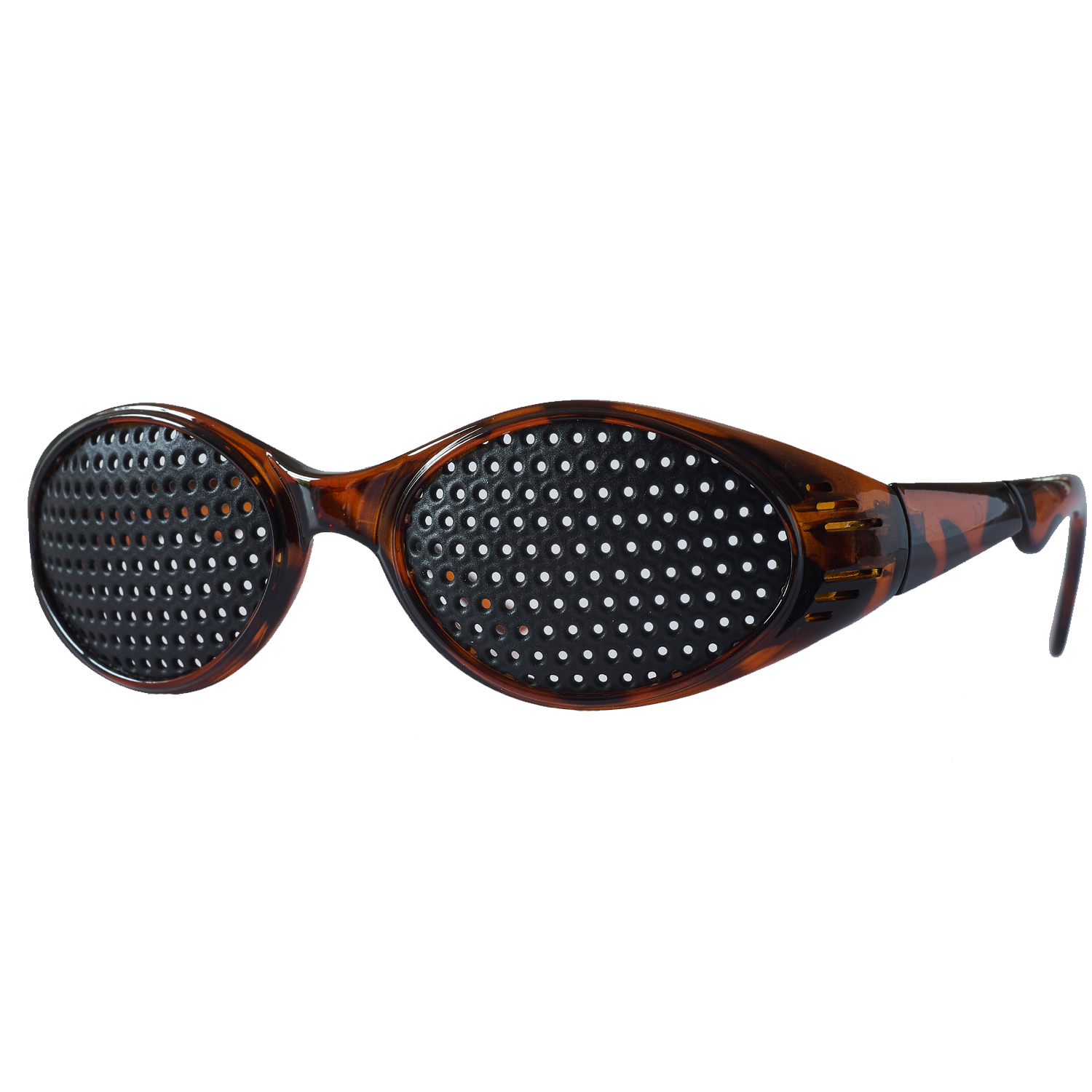
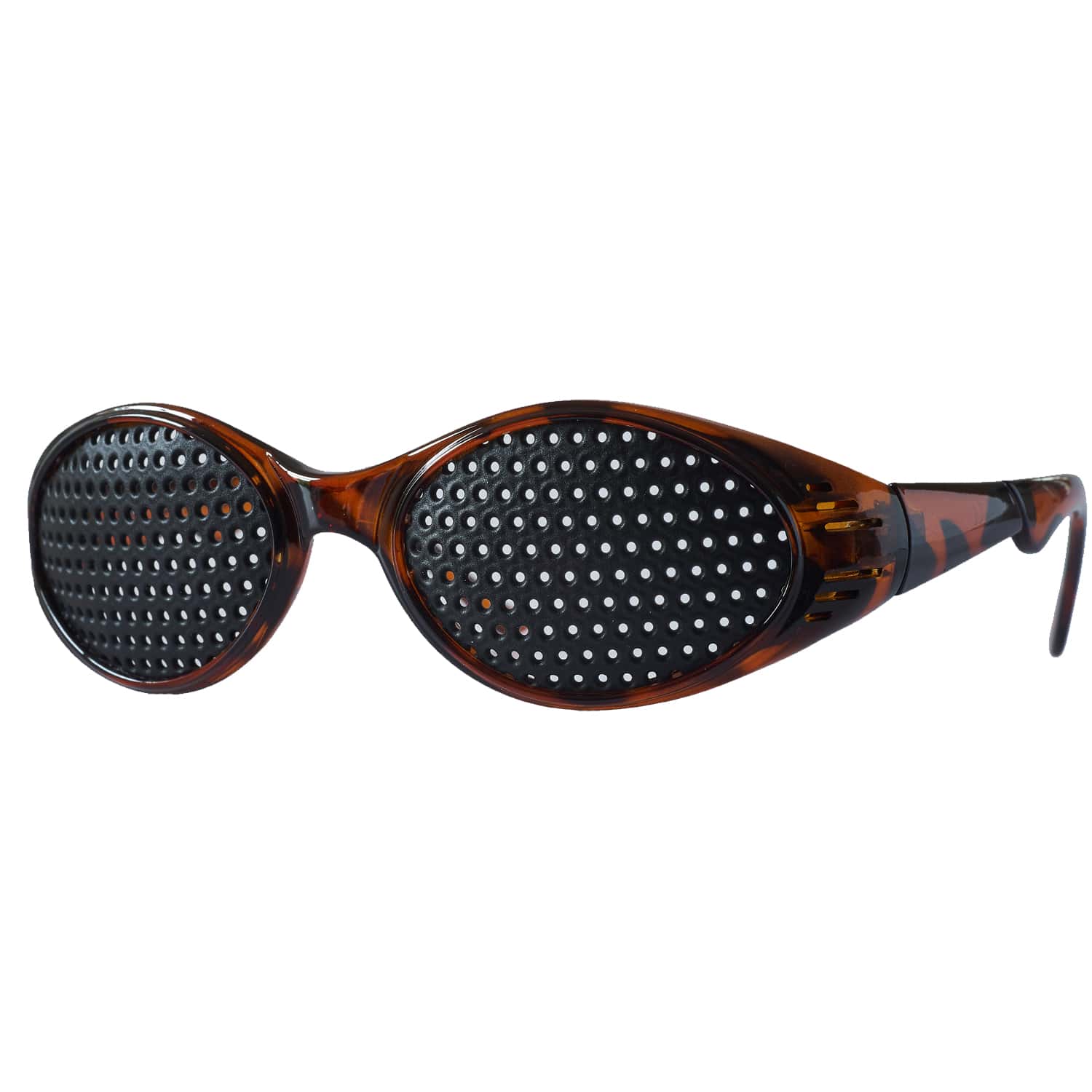
DimensionsScope of deliveryFrame width: 140 mmPinhole GlassesArm length: 115 mmGlasses caseBridge width: 20 mmOriginal Visus eye chart, the ideal aid for monitoring the progress of your eye trainingWeight: 20 gDetailed description of glassesRaster height: 35 mmGrid length: 55 mmGrid: classic round hole pattern The curved lenses have a full-surface, coarser round grid, which allows a particularly large amount of light to pass through. This type of grid is suitable for everyone and is often worn preventively. How to use the glasses in everyday life Use the Pinhole Glasses, also known as multidot glasses, for 10 to 20 minutes every day. Wear them while carrying out your usual activities at home or at work. For long-sightedness: ideal for close-up work such as reading For short-sightedness: useful for distance vision, e.g. when watching television or going for a walk Your advantages Training with pinhole glasses is a natural and holistic method for relaxed vision. The pinhole effect provides an image that is almost as clear as with conventional lenses. At the same time, the eye muscles are specifically activated by the brain to adjust the focus independently. Frame & comfort The narrow, brown spectacle frame in a sporty, fashionable style is suitable for both women and men. Side light protection ensures that your training sessions can proceed undisturbed. Maintaining eye health in stressful everyday life Traditional eye exercises are time-consuming and require a lot of discipline. Lattice or pinhole glasses, on the other hand, can be easily integrated into everyday life: you train your eyes while working on the computer, for example. A clever alternative for visual impairments In modern working life, our eyes are often subjected to one-sided strain: Adaptation: Difficulties in adjusting to light and dark conditions Accommodation: Problems switching between near and distant vision This strain can weaken your vision. Vision training with pinhole glasses breaks through this one-sidedness and supports more natural vision. William Bates – the origin of modern eye training William Bates, the founder of eye training, demonstrated through experiments that vision can be trained. The decisive factor here is not the lens of the eye, but the six external eye muscles. In 1920, he published his work Perfect Sight Without Glasses and developed exercises based on it, which are now known as the Bates method. Later, Janet Goodrich took up these approaches and published the first studies on grid and pinhole glasses. Additional product information Manufacturer: BioTec Dr. Egely & Lobmayer GmbH Sendlingerstr. 8, 84332 Hebertsfelden, Germany Telephone: +49 8721 910939 Email: info@biotec7.de Important information Do not use in road traffic. Clean only with mild agents – aggressive cleaners can damage the glasses.

Dimensions Scope of delivery Frame width: 140 mm Pinhole Glasses Temple length: 115 mm Glasses case Bridge width: 20 mm Original Visus eye chart, the ideal aid for monitoring the progress of your eye training Weight: 20 g Detailed description of glasses Grid height: 35 mm Grid length: 55 mm Grid: Bifocal dot grid With this type of grid, the dot grid in the upper viewing area of the curved lenses is smaller and denser, while in the lower viewing area it becomes larger and coarser. This enables a dynamic change in ‘focusing’ between relaxing (small holes) and training. Many years of experience show that this type of grid is preferred by people with over 3.0 dioptres. Use: Wear the Pinhole Glasses or multidot glasses for 10–20 minutes every day – while reading (for long-sightedness) or while watching television and walking (for short-sightedness). Benefits: As soon as the pinhole glasses are put on, the brain begins to control the eye muscles. The physical pinhole effect creates a clear image and the eye returns to its natural activity. Design: These black, slim-fit glasses frames for women and men make a fashionable, sporty statement. With side light protection, you can get the most out of your training sessions with these Multidot glasses. Maintaining eye health in our hectic times Traditional vision exercises to strengthen eyesight are time-consuming and require disciplined practice to compensate for long-term visual impairments. Training with pinhole glasses or pinhole glasses is compatible with modern ‘multitasking’. You can complete your daily training while doing other things, such as working on your computer. Eye training with pinhole glasses – an intelligent alternative for visual impairments In today's modern and complex working world, our eyes are exposed to one-sided strain: adaptation performance (problems with light-dark adjustment) and accommodation performance (problems with near-far adjustment). This often leads to declining vision. Vision training with pinhole glasses breaks through this one-sidedness of vision. The eye learns to see naturally again. The origin of eye training according to William Bates William Bates, the forefather of eye training, proved through numerous experiments that vision can be retrained. It is not the lens of the eye that is responsible for ‘focusing’ and visual acuity, but the activity of the six external eye muscles. In 1920, he published his findings in ‘Perfect Sight Without Glasses’. Bates developed simple eye exercises for various visual impairments, known as the Bates Method. Later, Janet Goodrich built on this and published the first studies on grid or pinhole glasses. Additional product information: Manufacturer: BioTec Dr. Egely & Lobmayer GmbH, Sendlingerstr. 8, 84332 Hebertsfelden, Germany, Telephone: +49 8721 910939, Email: info@biotec7.de Warnings and safety instructions: Must not be used in road traffic. Improper cleaning or aggressive cleaning agents can damage the glasses.

DimensionsScope of deliveryFrame width: 140 mmPinhole GlassesTemple length: 130 mmGlasses caseBridge width: 15 mmOriginal Visus eye chart, the ideal aid for monitoring the progress of your eye trainingWeight: 21 gDetailed description of glassesGrid height: 40 mmGrid length: 70 mmGrid: pyramidal grid The curved lenses have a scratch-resistant, square grid arranged in a pyramid shape. Experience shows that this full-surface grid is preferred for less than 2.0 dioptres and serves as prevention for non-spectacle wearers. Use: 10 to 20 minutes of daily training is sufficient: wear the Pinhole Glasses or multidot glasses during your routine tasks at home or at work. Long-sighted people use the glasses for close-up tasks such as reading, while short-sighted people activate their eyes when watching television or relaxing and looking into the distance, e.g. when going for a walk. Benefits: The pinhole glasses use the physical pinhole effect, which enables almost sharp vision – without the need for ground lenses. At the same time, the brain stimulates the eye muscles, training natural vision and keeping the muscles flexible. Design: The shiny black model with an angular upper frame and solid frame combines stylish design with high stability. Reinforced frame ends and silicone nose pads ensure comfortable wear. An attractive, fashionable accessory for men and women. Maintaining eye health in our hectic times Traditional vision exercises are time-consuming and require discipline. With pinhole glasses, you can integrate daily vision training into your everyday life – while working on the computer or performing other routine tasks – and thus actively prevent visual impairments. Eye training – an intelligent alternative for visual impairments In modern working life, our eyes are often subjected to one-sided strain, for example when adjusting to light and dark or switching between near and far vision. Pinhole glasses break through this one-sidedness and promote natural vision. The origins of eye training according to William Bates William Bates proved that visual acuity does not depend solely on the lens of the eye, but also on the activity of the six external eye muscles. In 1920, he published his findings in ‘Perfect Sight Without Glasses’. His method is based on simple eye exercises, which were later expanded upon by vision trainer Janet Goodrich and investigated in studies on grid and pinhole glasses. Additional product information: Manufacturer: BioTec Dr. Egely & Lobmayer GmbH, Sendlingerstr. 8, 84332 Hebertsfelden, Germany, Telephone: +49 8721 910939, Email: info@biotec7.de Warnings and safety instructions: Do not use in road traffic. Improper cleaning or aggressive cleaning agents can damage the glasses.

Dimensions Scope of delivery Frame width: 140 mm Pinhole Glasses Temple length: 115 mm Glasses case Bridge width: 20 mm Original Visus eye chart, the ideal aid for monitoring the progress of your eye training Weight: 20 g Detailed description of glasses Grid height: 35 mm Grid length: 55 mm Grid: Bifocal dot grid With this type of grid, the dot grid in the upper viewing area of the curved lenses is smaller and denser, while in the lower viewing area it becomes larger and coarser. This enables a dynamic change in ‘focusing’ between relaxation (small holes) and training. Many years of experience show that this type of grid is preferred by people with more than 3.0 dioptres. Use: Perform a 10–20-minute training session every day with the Pinhole Glasses or Multidot Glasses. Wear them regularly as part of your daily routine at home and at work. Long-sighted people use them when reading, while short-sighted people use them when watching television, working on the computer or focusing on distant objects. Benefits: The pinhole glasses use a physical effect to achieve visual acuity that is close to that of optical glasses. Meanwhile, the eye remains active as the brain stimulates the muscles to focus – a natural vision training exercise. Design: These blue, slim-fit glasses frames for women and men make a fashionable, sporty statement. With side light protection, you can get the most out of your training sessions. Maintaining eye health in our hectic times Traditional vision exercises to strengthen eyesight are time-consuming and require disciplined practice to compensate for long-term visual impairments. Training with pinhole glasses or pinhole glasses supports modern ‘multitasking’. You can complete your daily training while working on the computer, for example. Eye training with pinhole glasses – an intelligent alternative for visual impairments In the modern working world, our eyes are exposed to one-sided strain: adaptation performance (problems with light-dark adjustment) and accommodation performance (problems with near-far adjustment). This often leads to declining vision. Vision training with pinhole glasses breaks through this one-sidedness of vision. The eye learns to see naturally again. The origin of eye training according to William Bates William Bates, the forefather of eye training, proved through numerous experiments that vision can be retrained. It is not the lens of the eye that is responsible for ‘focusing’ and visual acuity, but the activity of the six external eye muscles. In 1920, he published his empirical findings in his classic work ‘Perfect Sight Without Glasses’. Bates developed simple eye exercises for various visual impairments, known as the Bates method. Later, Janet Goodrich built on this and published the first studies on grid and pinhole glasses. Additional product information: Manufacturer: BioTec Dr. Egely & Lobmayer GmbH, Sendlingerstr. 8, 84332 Hebertsfelden, Germany, Telephone: +49 8721 910939, Email: info@biotec7.de Warnings and safety instructions: Must not be used in road traffic. Improper cleaning or aggressive cleaning agents can damage the glasses.
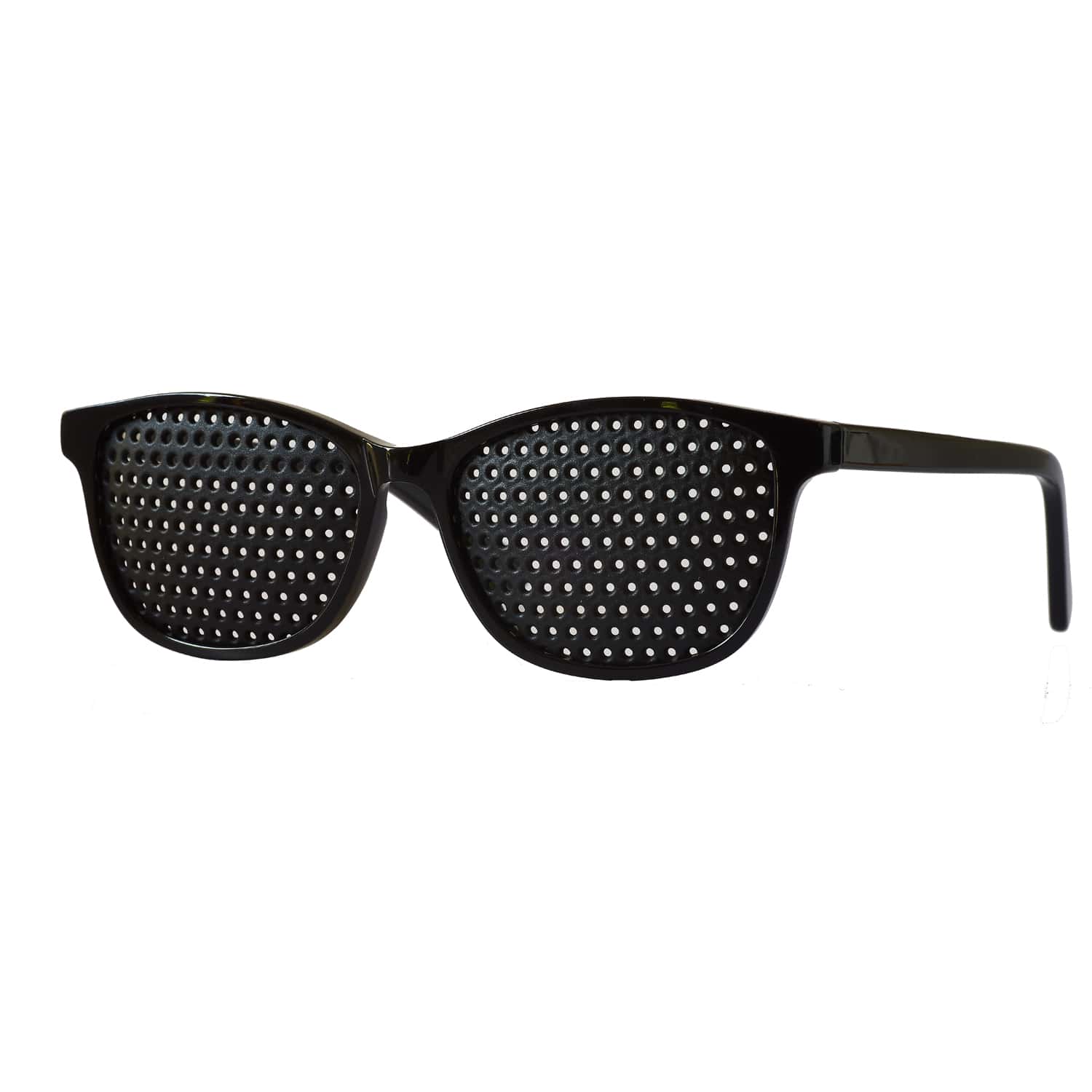
Dimensions Scope of delivery Frame width: 130 mm Pinhole Glasses Temple length: 140 mm Spectacle case Bridge width: 15 mm Original Visus eye chart, the ideal aid for monitoring the progress of your eye training Weight: 20 g Detailed spectacle description Raster height: 35 mm Grid length: 53 mm Design: The first Pinhole glasses made from organic materials! These raster glasses, sustainably crafted from cotton fibres using traditional methods, meet the highest standards for eyewear. Dimensionally stable Easy to clean No moisture or temperature fluctuations Advantages over conventionally manufactured glasses: Very lightweight Silky sheen Optimal wearing comfort (no pressure on the bridge of the nose) User-friendly and recyclable material Easy to repair Mesh: Conventional round hole pattern The curved lenses have a full-surface (coarser) round hole pattern, thus offering the greatest light incidence. This type of grid is suitable for everyone and is also worn for preventative purposes. Use: 10 to 20 minutes of daily training with the grid glasses. Wear the grid glasses regularly during your routine tasks at home and at work. If you are long-sighted, wear the grid glasses at close range, e.g. when reading. If you are short-sighted, simply let your eyes ‘jog’ with the grid glasses – also known as multidot glasses – while watching television, working at a screen or focusing into the distance during a relaxing walk. Benefits: Training with pinhole glasses is a holistic method for relaxed and natural vision. Based on the physical ‘pinhole effect’, pinhole glasses allow you to see almost as sharply as with optically ground glasses. Why is this the case? As soon as the grid glasses are worn, the brain sends out light signals that stimulate the eye muscles to focus the image sharply. The eye is thus ‘forced’ to perform its natural function again, namely to be constantly in motion through the work of focusing. With corrective glasses, the ‘built-in’ magnification largely takes over this work of focusing, leading to the weakening of the eye muscles over time. The grid glasses lead to an approx. 50% beneficial calming of the retina and influence the entire eye organism, such as the eyes' perception, colour perception and light tolerance. Design: The emphatically purist frame is unisex. A metal spring hinge ensures durability. The simplicity of the glasses is complemented by the velvety-silky sheen on the black frame and also makes an environmentally conscious statement. Maintaining eye health in our hectic times Traditional vision exercises to strengthen eyesight are time-consuming and require disciplined practice to compensate for visual impairments in the long term. Training with grid glasses or pinhole glasses is well suited to modern ‘multitasking’. You can complete your daily training while doing other things, such as working on the computer. Eye training with grid glasses – an intelligent alternative for visual impairments In the modern and complex world of work, our eyes are exposed to one-sided strain on their adaptive capacity (problems with light-dark adjustment) and one-sided strain on their accommodative capacity (problems with near-far adjustment). These are usually the cause of declining vision or the development of vision problems. Vision training with pinhole glasses ‘breaks through’ this one-sidedness of vision. The eye learns to see naturally again. The origins of eye training according to William Bates William Bates, the forefather of eye training, proved through numerous experiments that vision can be retrained. According to his findings, it was not the lens of the eye that was responsible for ‘focusing’ and/or visual acuity, but rather the activity of the six external eye muscles. In 1920, he published his empirical findings in his classic work ‘Perfect Sight Without Glasses’. Based on his theory, Bates developed simple eye exercises for various visual impairments. This is known as the ‘Bates Method’. Later, the luminary among vision trainers, Janet Goodrich, built on the Bates Method and published the first studies on grid glasses or pinhole glasses. Additional product information: Manufacturer: BioTec Dr. Egely & Lobmayer GmbH, Sendlingerstr. 8, 84332 Hebertsfelden, Germany, Telephone: +49 8721 910939, Email: info@biotec7.de Warnings and safety instructions: Must not be used in road traffic. Unsuitable cleaning: The use of aggressive cleaning agents or improper handling can damage the glasses.
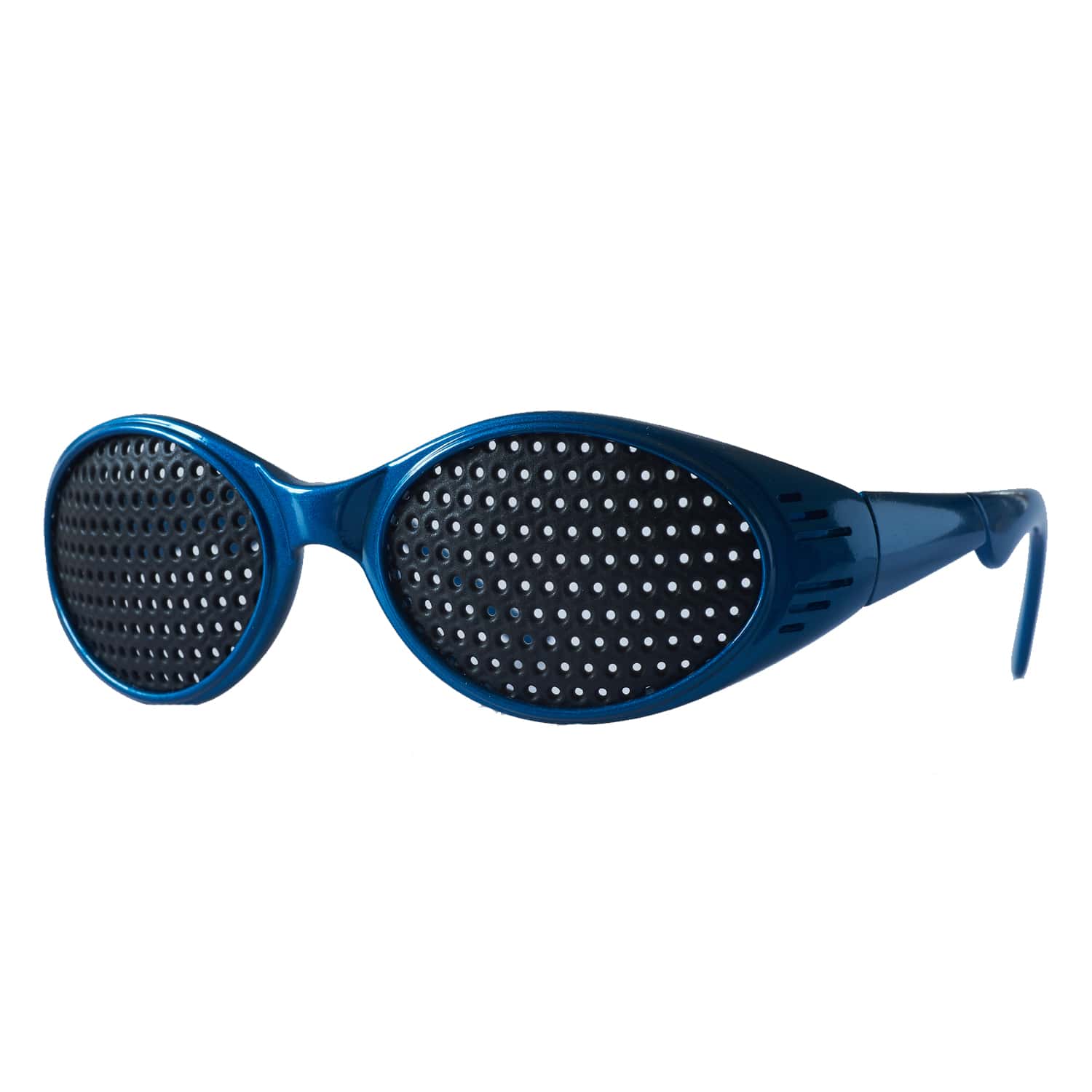
DimensionsScope of deliveryFrame width: 140 mmPinhole GlassesArm length: 115 mmSpectacle caseBridge width: 20 mmOriginal Visus eye chart, the ideal aid for monitoring the progress of your eye trainingWeight: 20 gDetailed spectacle descriptionRaster height: 35 mmGrid length: 55 mmGrid: classic round hole pattern The curved lenses feature a full-surface, slightly coarser round grid, allowing a particularly large amount of light to enter. This type of grid is suitable for everyone and can also be worn preventively. How to use the glasses Wear the Pinhole Glasses – also known as multidot glasses – every day for 10 to 20 minutes while performing y
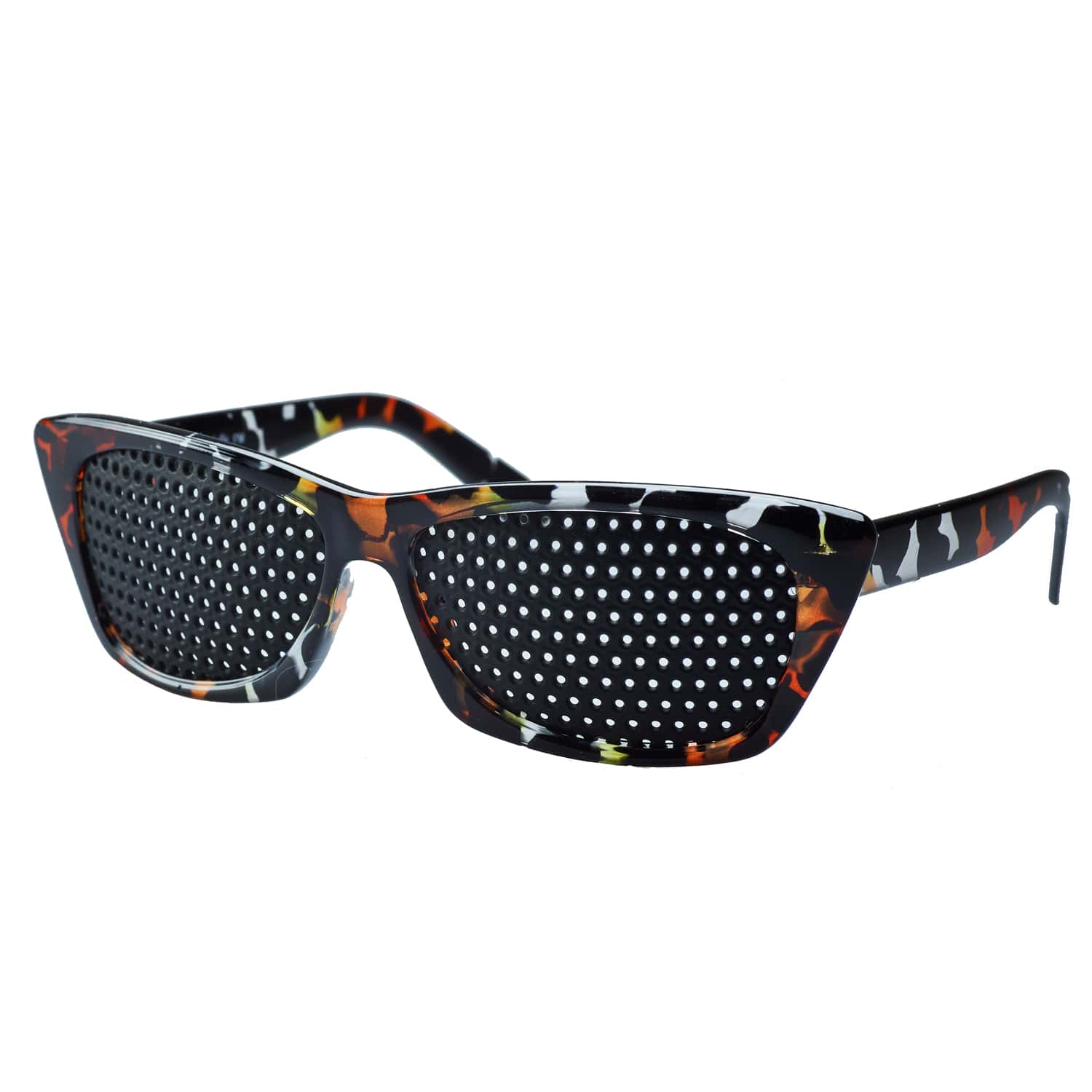
DimensionsScope of deliveryFrame width: 140 mmPinhole GlassesTemple length: 130 mmGlasses caseBridge width: 15 mmOriginal Visus eye chart, the ideal aid for monitoring the progress of your eye trainingWeight: 21 gDetailed description of glassesGrid height: 40 mmGrid length: 70 mmGrid: classic round hole grid The curved lenses feature a large, coarse round grid, which allows a particularly large amount of light to enter the eye. This type of grid is suitable for almost everyone and is often worn for preventive purposes. Recommended use Wear the Pinhole Glasses or multidot glasses for 10–20 minutes every day. You can wear them comfortably during everyday activities: Long-sightedness: when reading or performing other close-up tasks Nearsightedness: when watching television or looking at distant objects Effect & impact Vision training with pinhole glasses is based on the physical pinhole effect. This creates an almost sharp image – without the need for optical lenses. At the same time, the brain stimulates the eye muscles to actively focus, which promotes natural vision. Design & style Fashionable spectacle frames with a striking shape: feminine look, angular at the top, in a brown tiger-striped design with solid frames. High-quality workmanship and comfortable to wear make them a functional and elegant accessory. Maintaining eye health in everyday life Classic vision exercises require a lot of time and discipline. Training with grid or pinhole glasses, on the other hand, is suitable for everyday use and supports modern multitasking. This allows you to complete your vision exercises while performing activities such as working on the computer. Pinhole glasses as an alternative for visual impairments In modern working life, the eyes are often subjected to one-sided strain: Adaptation: problems with light-dark adjustment Accommodation: Difficulties switching between near and far vision These factors often lead to declining vision. Training with pinhole glasses breaks through this one-sidedness and supports natural vision. The origins of eye training according to William Bates William Bates, founder of modern eye training, demonstrated in numerous experiments that vision can be trained. He discovered that it is not the lens, but the outer six eye muscles that are responsible for focusing. In 1920, he published his findings in Perfect Sight Without Glasses. Based on this, he developed the Bates Method with simple vision exercises. Later, Janet Goodrich took up these approaches and wrote the first studies on the effect of grid and pinhole glasses. Additional product information Manufacturer: BioTec Dr. Egely & Lobmayer GmbH Sendlingerstr. 8, 84332 Hebertsfelden, Germany Telephone: +49 8721 910939 Email: info@biotec7.de Warnings and safety instructions Do not use in road traffic. Do not use aggressive cleaning agents, as these can damage the glasses.

Dimensions Scope of delivery Frame width: 130 mm Pinhole Glasses Temple length: 135 mm Glasses case Bridge width: 16 mm Original Visus eye chart – the ideal aid for monitoring the progress of your eye training Weight: 18 g Detailed description of glasses Grid height: 40 mm Grid length: 50 mm Grid: bifocal dot grid With this type of grid, the dot grid in the upper viewing area of the curved lenses is smaller and denser, while in the lower viewing area it becomes larger and coarser. This enables a dynamic change in ‘focusing’ between relaxing (small holes) and training. Many years of experience show that this type of grid is preferred by people with more than 3.0 dioptres. Use: 10–20 minutes of daily use of Pinhole Glasses or multidot glasses. Use them for routine tasks around the house or at work. For long-sightedness, we recommend using them for close-up tasks, such as reading. For short-sightedness, use them when looking into the distance – for example, when watching television or going for a walk. Benefits: When wearing Pinhole Glasses, the physical effect of the pinhole aperture achieves amazing visual acuity. At the same time, the brain encourages the eye muscles to work together – the natural mobility and focus of the eye are activated. Design: The stylish frame, made of high-quality gold-colored metal, can be worn by both women and men. Silicone nose pads and reinforced plastic ends make this model extremely comfortable to wear. Maintaining eye health in our hectic times Traditional vision exercises to strengthen eyesight are time-consuming and require disciplined practice to compensate for visual impairments in the long term. Training with pinhole glasses or pinhole glasses is ideal for modern ‘multitasking’: you can complete your daily training while doing your work on the computer, for example. Eye training with pinhole glasses – an intelligent alternative for visual impairments In today's modern and complex working world, our eyes are exposed to one-sided strain on their adaptive capacity (problems with light-dark adjustment) and their accommodative capacity (problems with near-far adjustment). These are usually the cause of declining eyesight or the development of vision problems. Vision training with pinhole glasses ‘breaks through’ this one-sidedness of vision. The eye learns to see naturally again. The origins of eye training according to William Bates William Bates, the forefather of eye training, proved through numerous experiments that vision can be retrained. According to his findings, it was not the lens of the eye that was responsible for focusing and visual acuity, but rather the activity of the six external eye muscles. According to his findings, it was not the lens of the eye that was responsible for ‘focusing’ and visual acuity, but rather the activity of the six external eye muscles. In 1920, he published his empirical findings in his classic work ‘Perfect Sight Without Glasses’. Based on his theory, Bates developed simple eye exercises for various visual impairments – known as the ‘Bates Method’. Later, the luminary among vision trainers Janet Goodrich built on the Bates method and published the first studies on pinhole glasses and pinhole glasses. Additional product information: Manufacturer: BioTec Dr. Egely & Lobmayer GmbH, Sendlinger Str. 8, 84332 Hebertsfelden, Germany, Telephone: +49 8721 910939, Email: info@biotec7.de Warnings and safety instructions: Must not be used in road traffic. Inappropriate cleaning: The use of aggressive cleaning agents or improper handling can damage the glasses.


